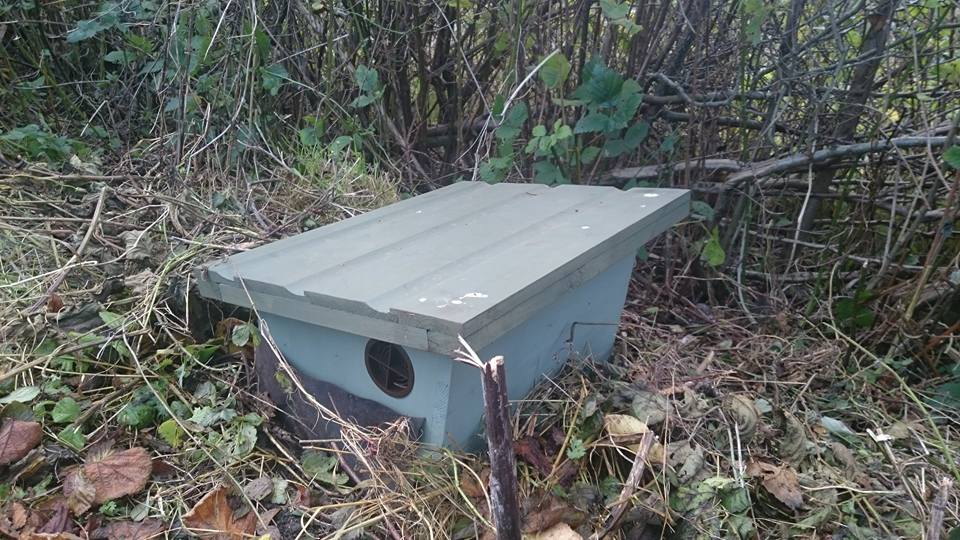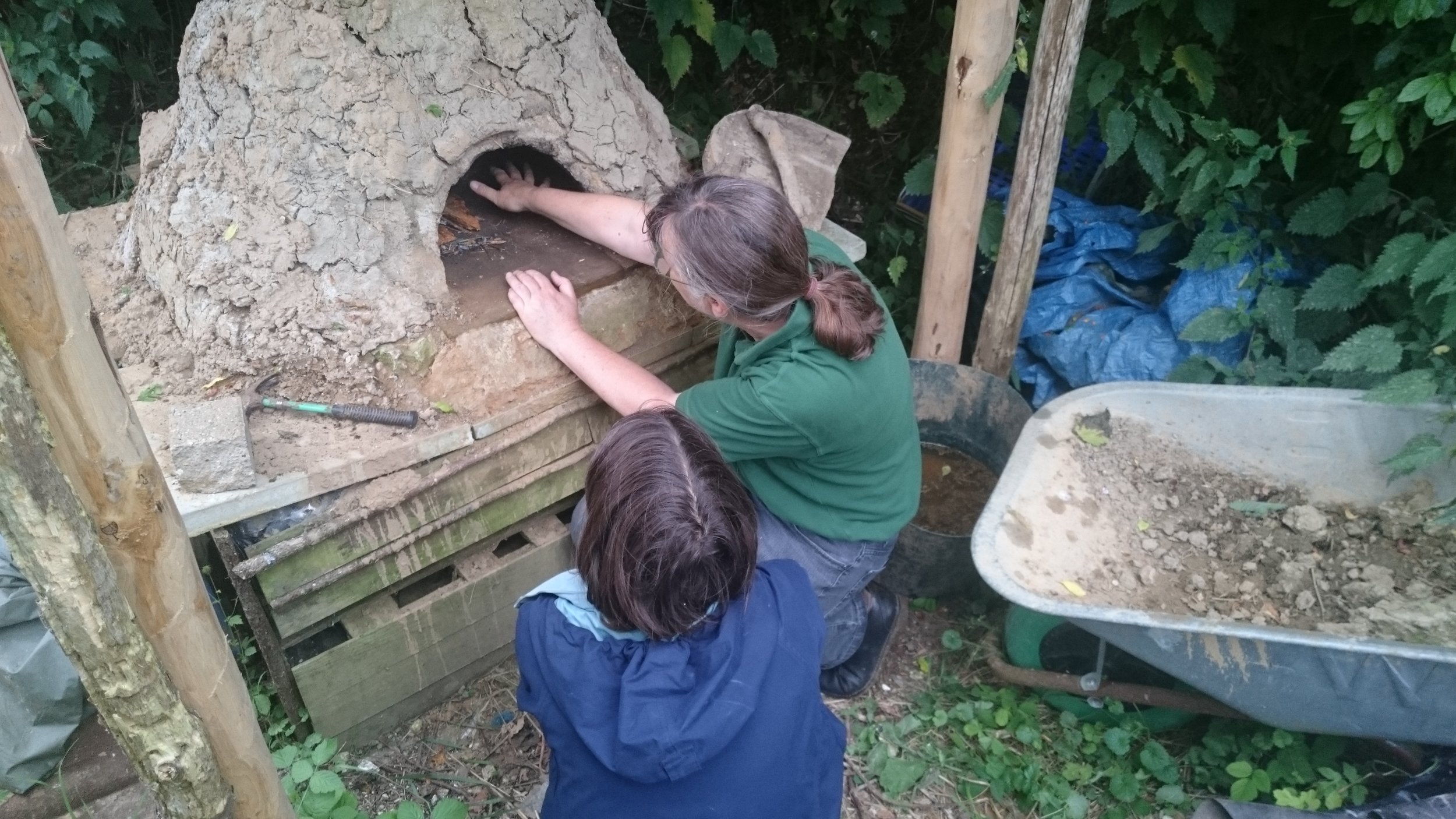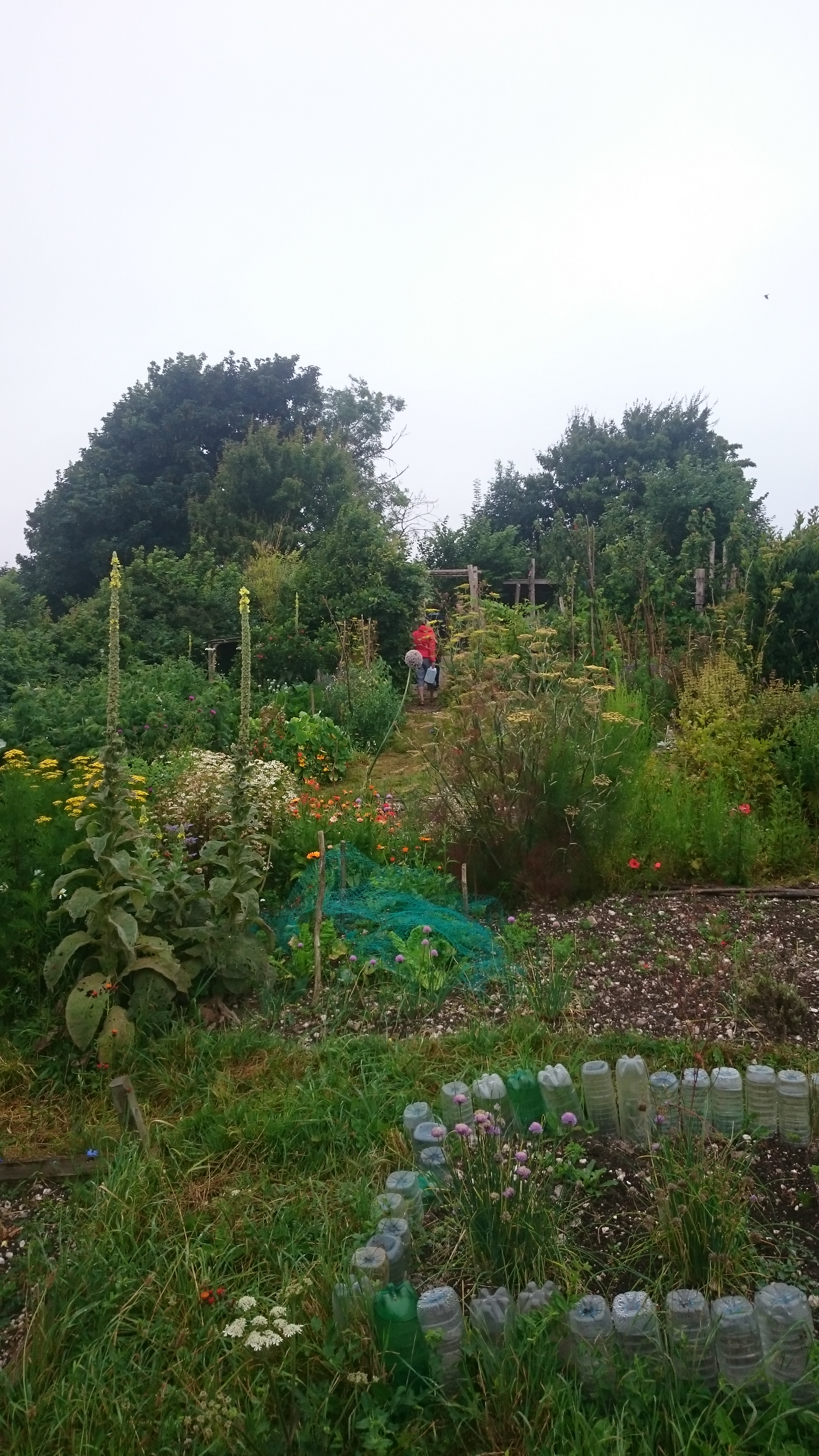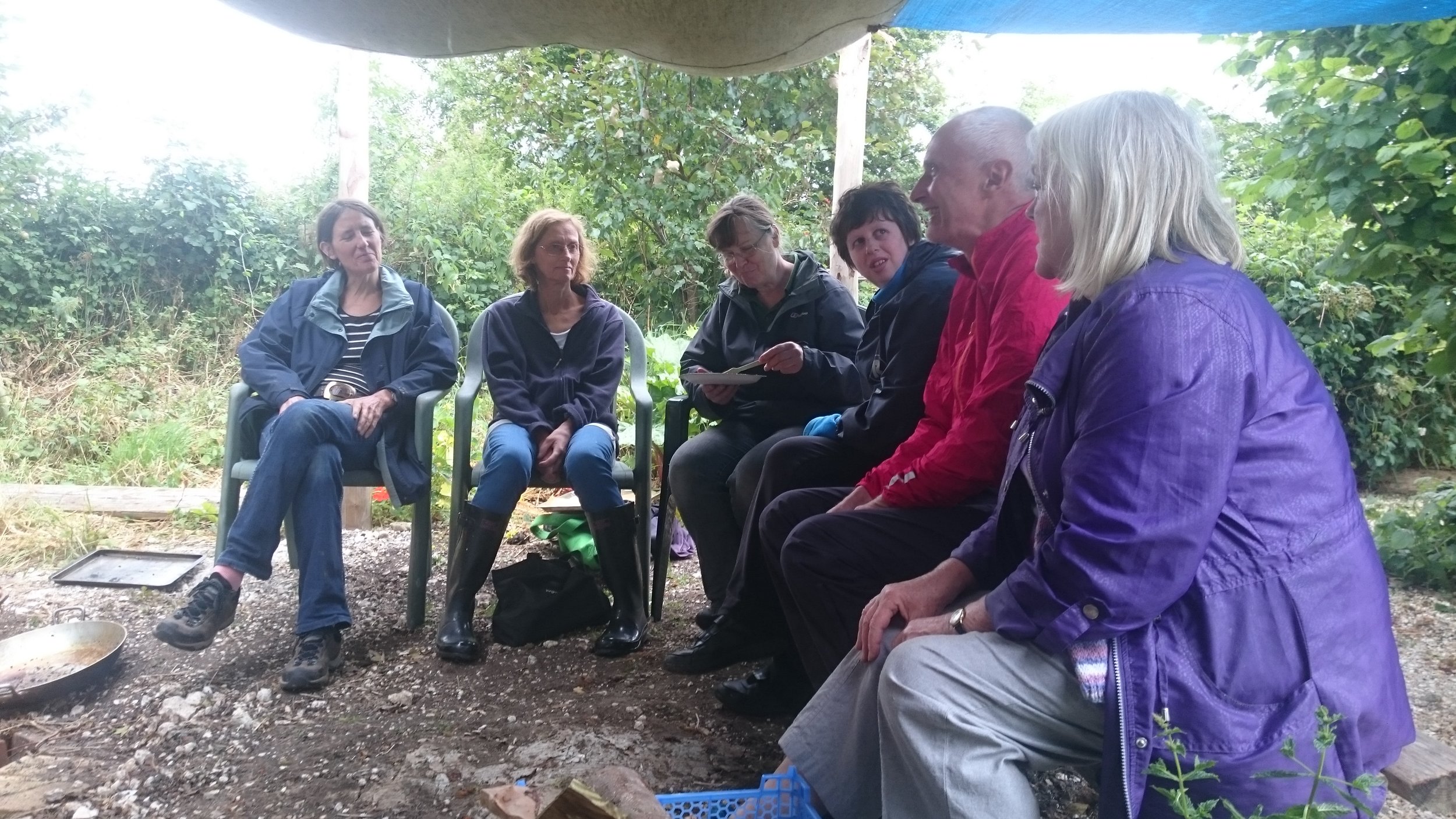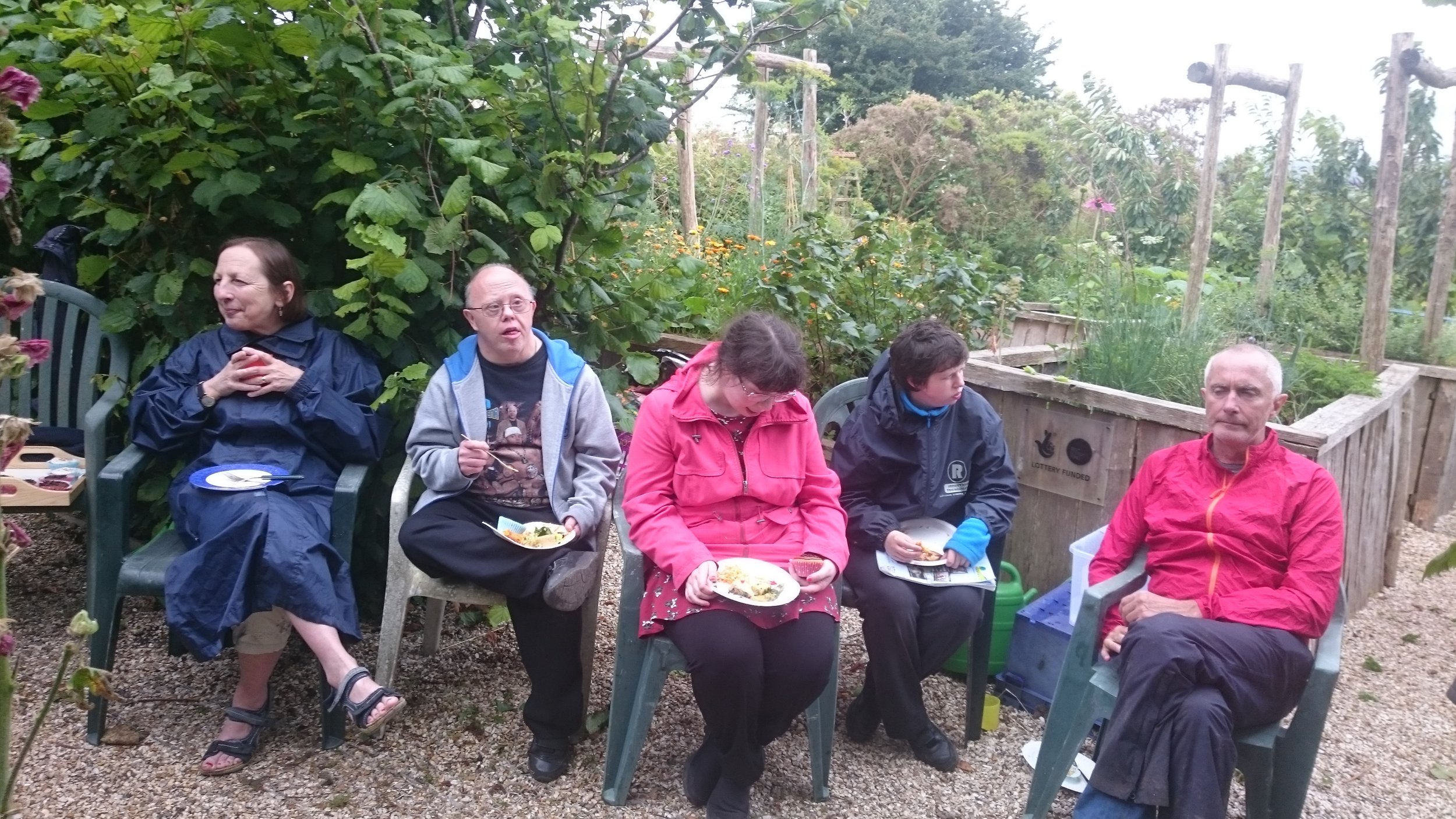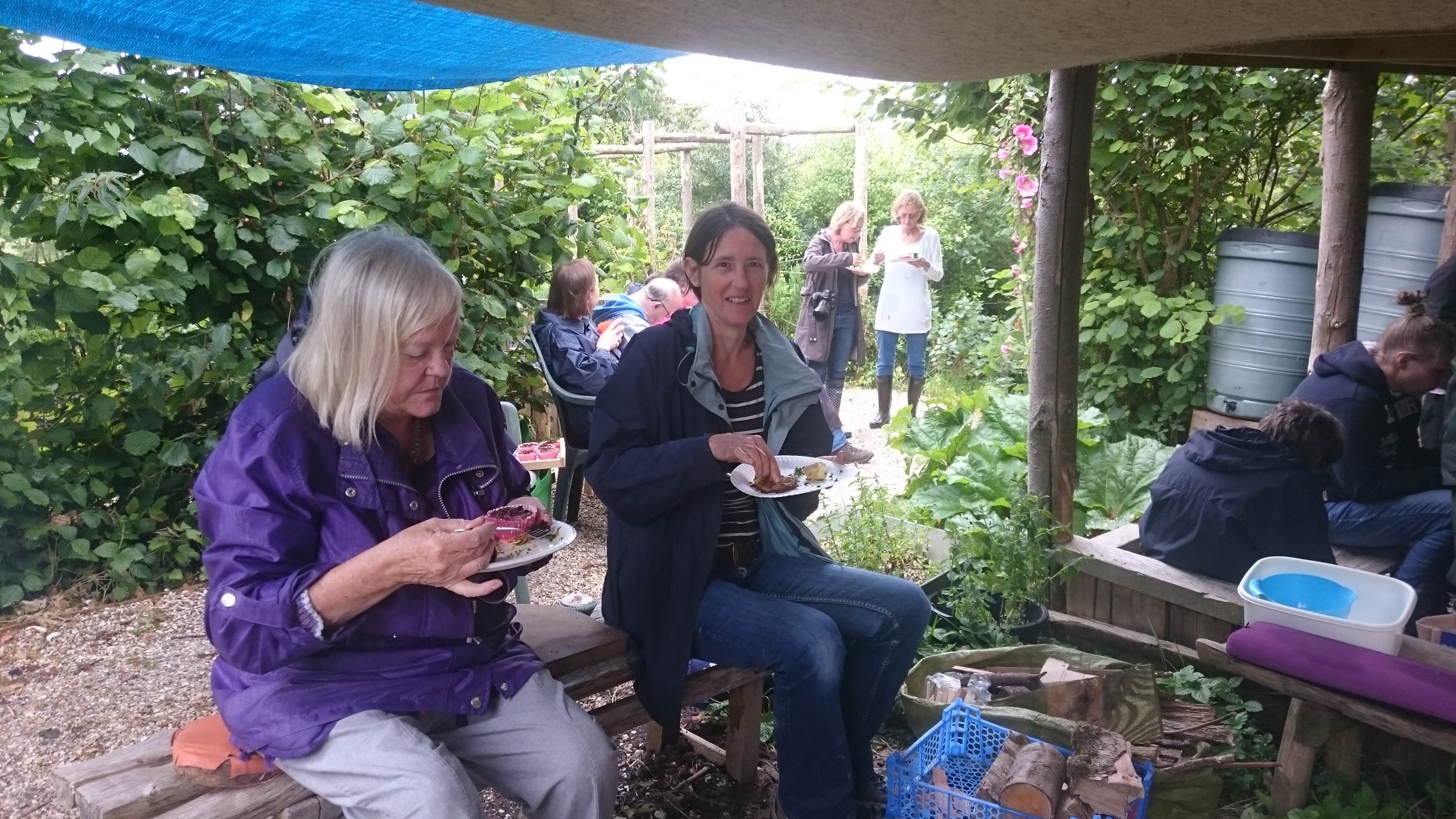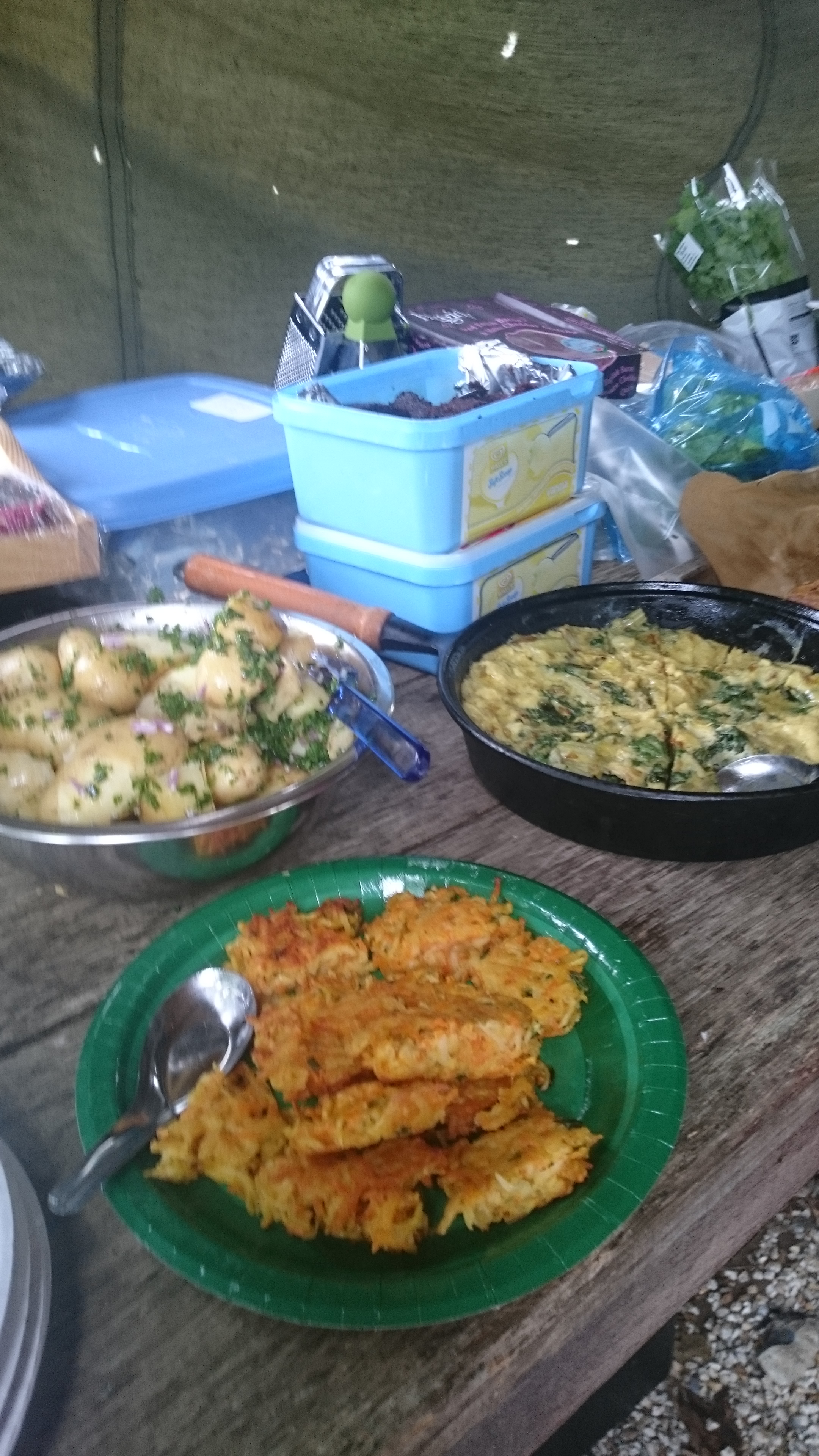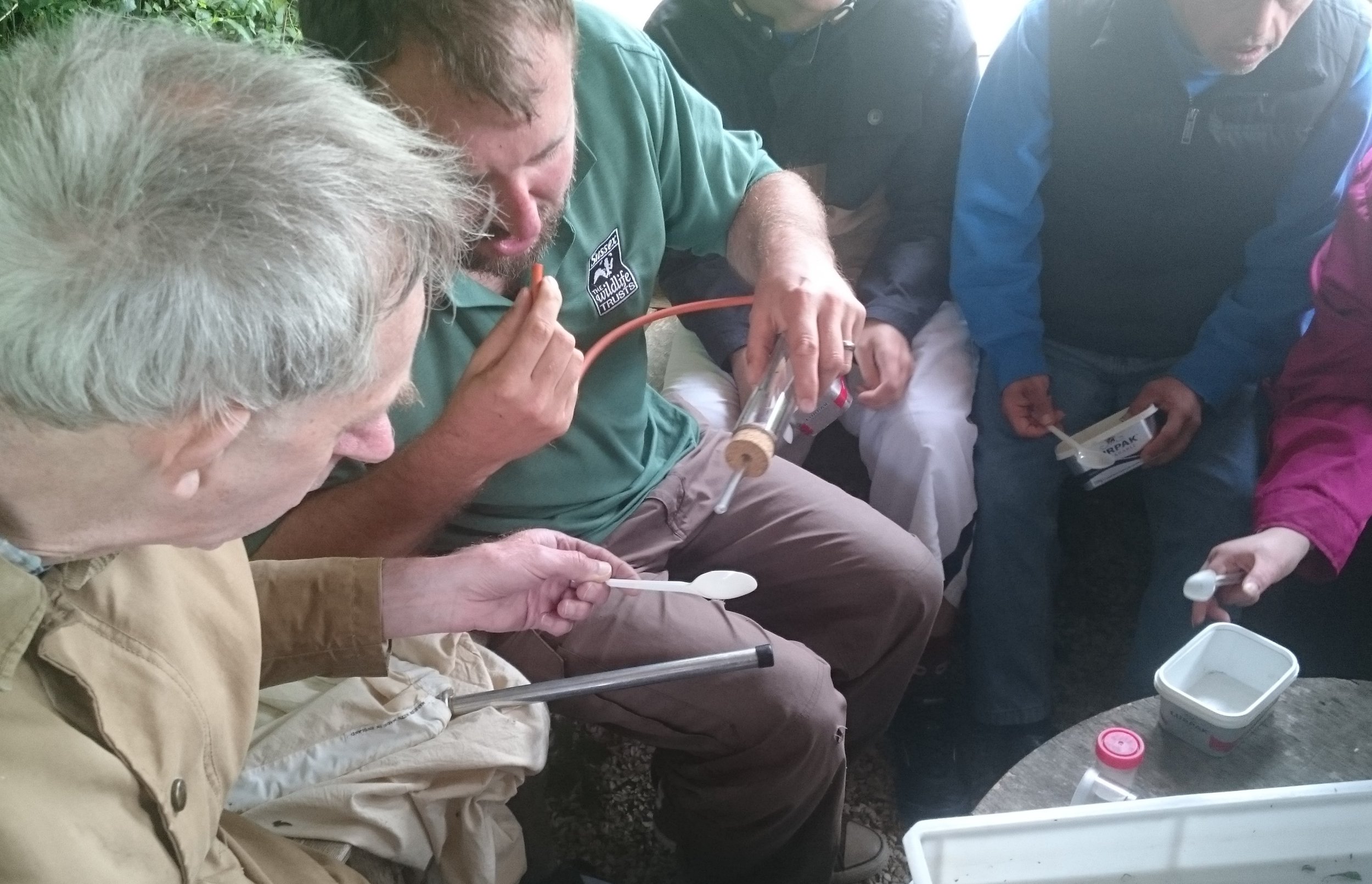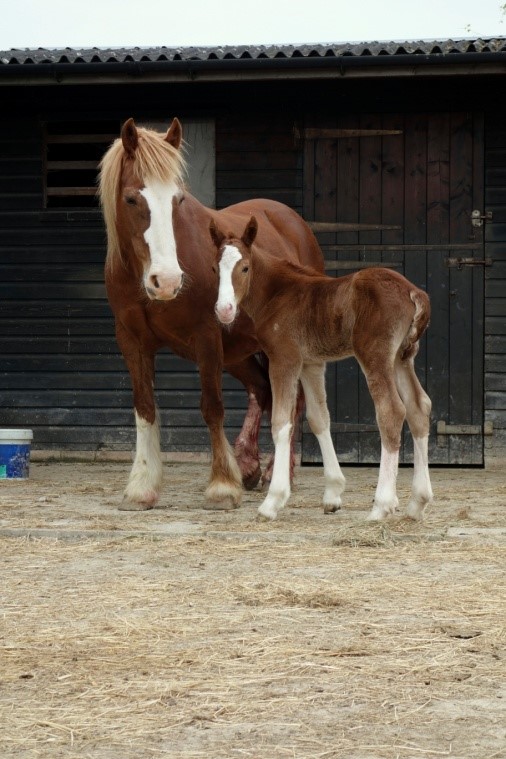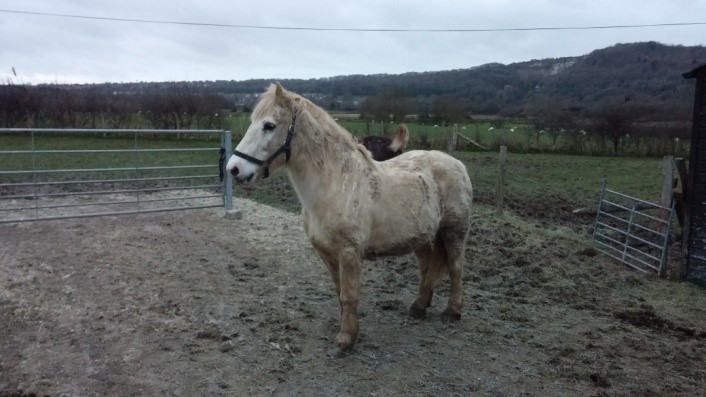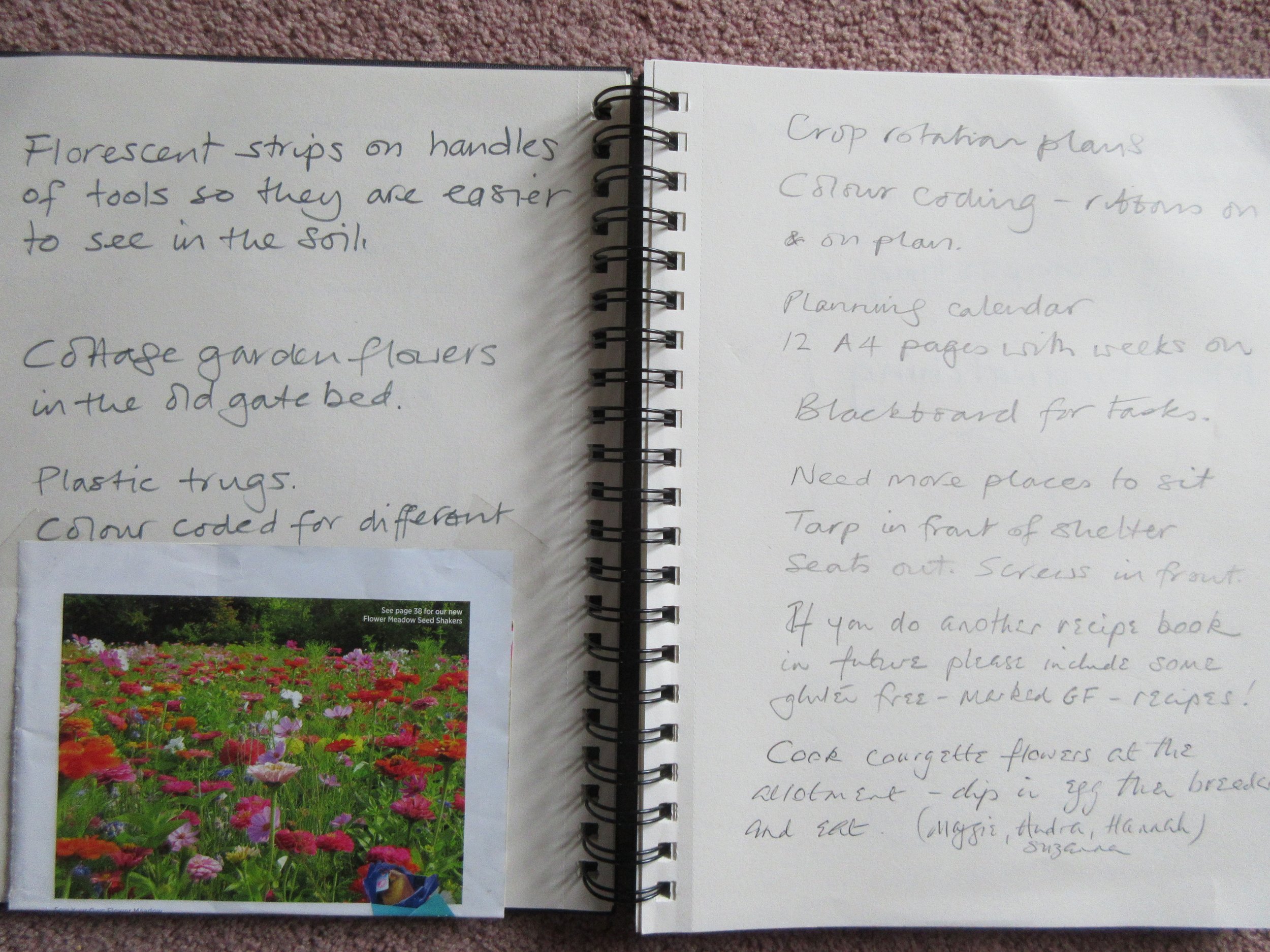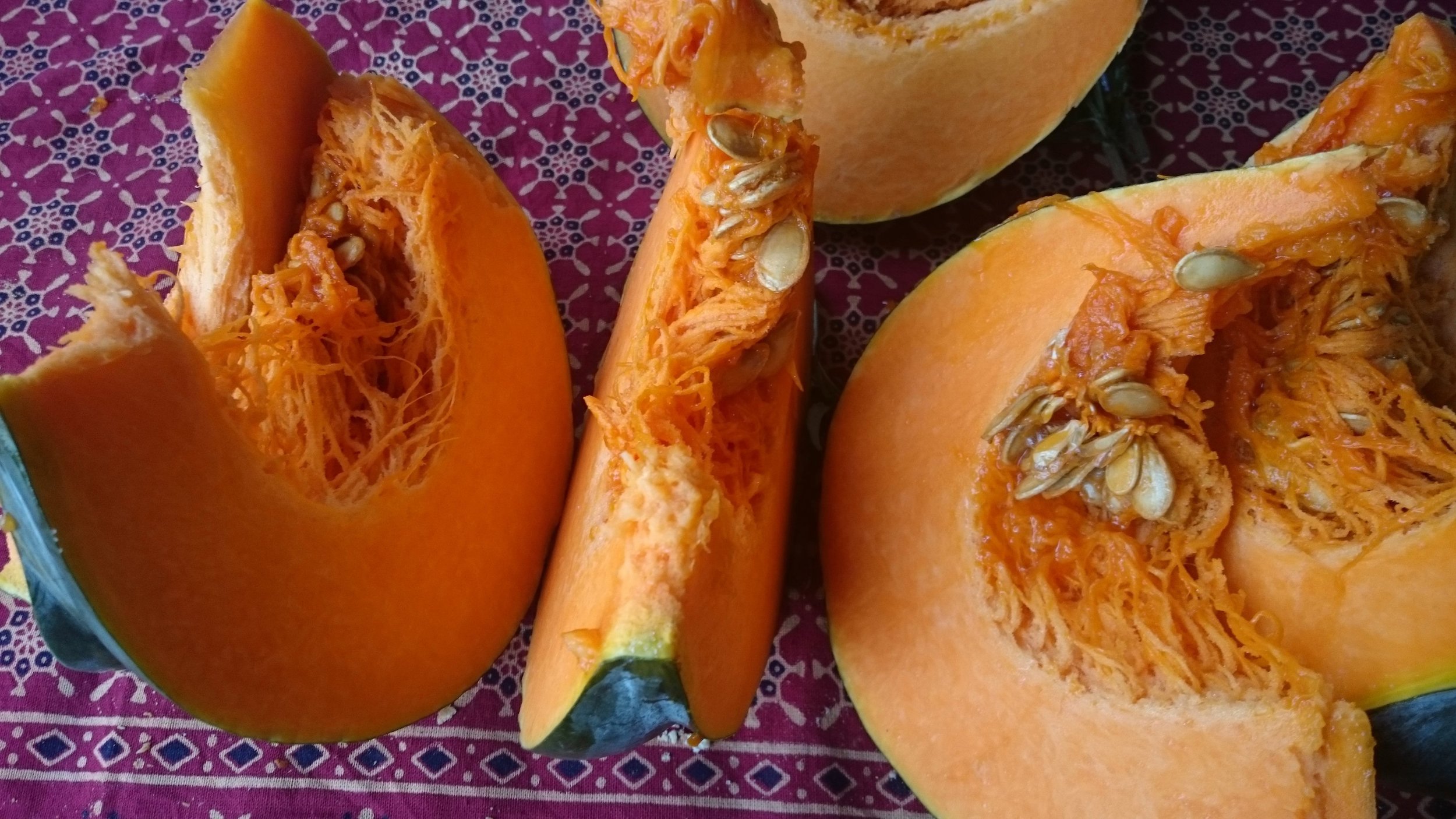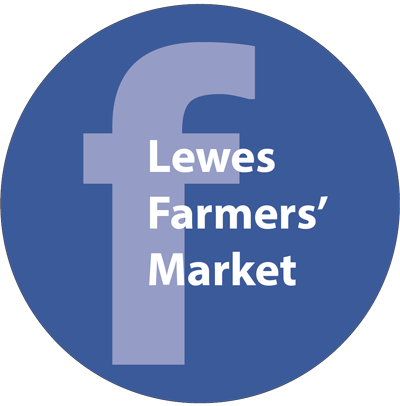This is a short video made by Louise Hill-Hottinger about Susannah, one of Flourish's service users at Lewes Community Allotment. Susannah is going to Plumpton College in September 2016 to begin their supported internship programme.
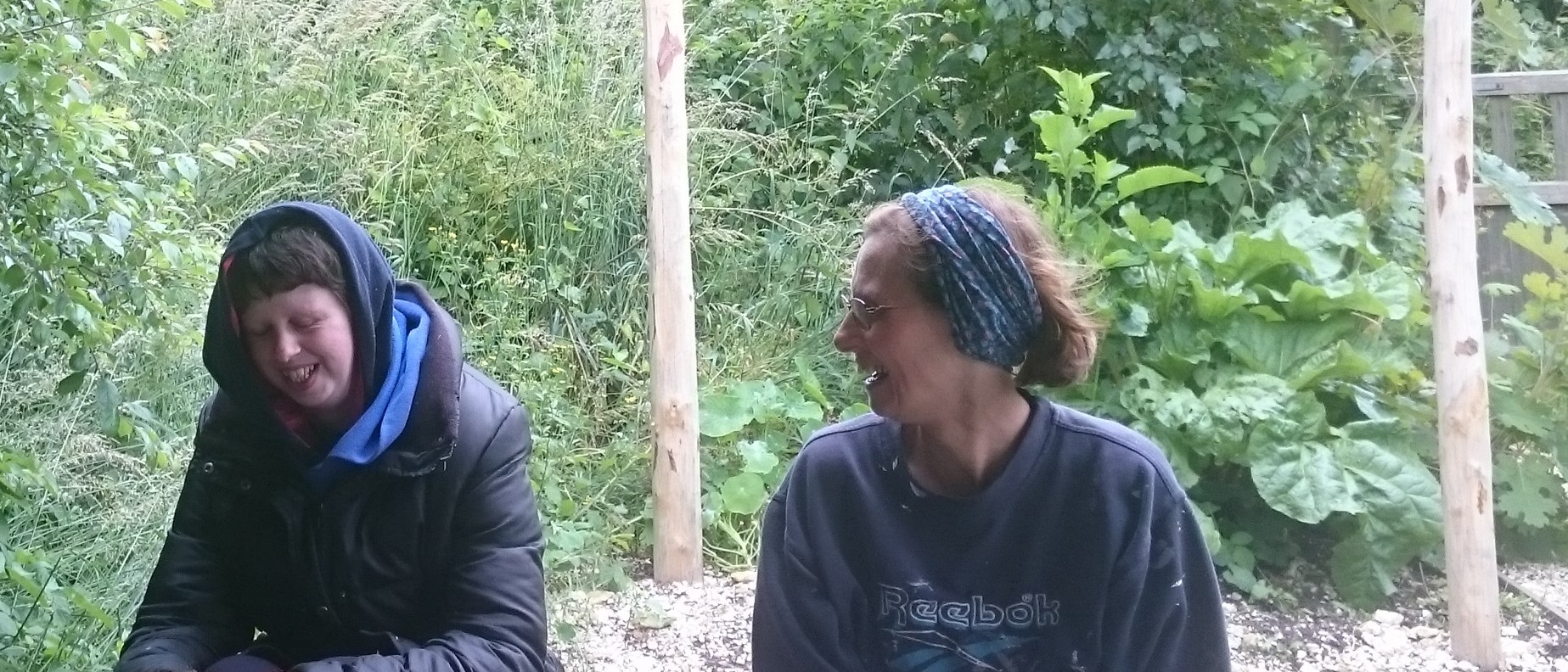
Summer Fire & Feast with Sophie Orloff
We'd been having lot of lovely sunny weather, but on this morning, the sun hid from us and it was a bit breezy, with an occasional shower. But Allotment Co-ordinator Sarah had set up the tarpaulin to enable partial shelter, and we got the fire going in the firepit no problem.
The group from St Nicholas Day Centre arrived with their support worker, plus some members came. We were pleased to meet a new person, Mary, who wanted to see what we do.
Common Cause director Topsy fired-up the recently repaired bread oven. As she did this, Sophie sent the group to pick and pod peas, so we could make pea bread (literally, bread dough she had brought mixed with fresh peas! The idea had come from something Sophie had seen about ancient bread recipes using peas). Allotment member (and bread maker) Susan helped make the rolls.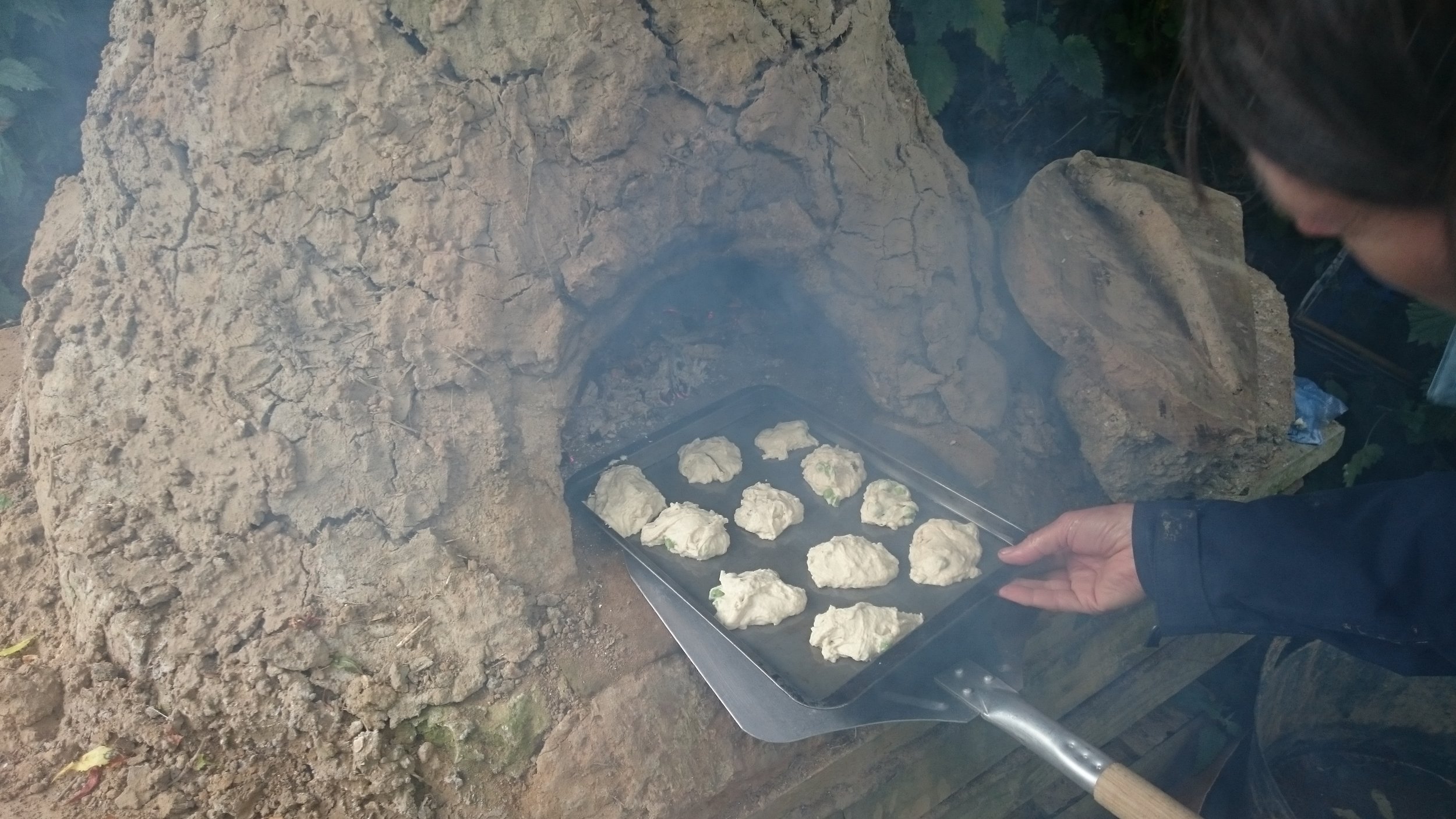
Some people picked edible flowers with Sarah for the salad, plus some herbs for some potato salad. In the meantime, Sophie showed the group how to make two kinds of fritters - one from grated courgette, and one from grated carrot and parsnip. In both cases she asked the group to help her mix the veg with flour, eggs and salt and pepper to season.
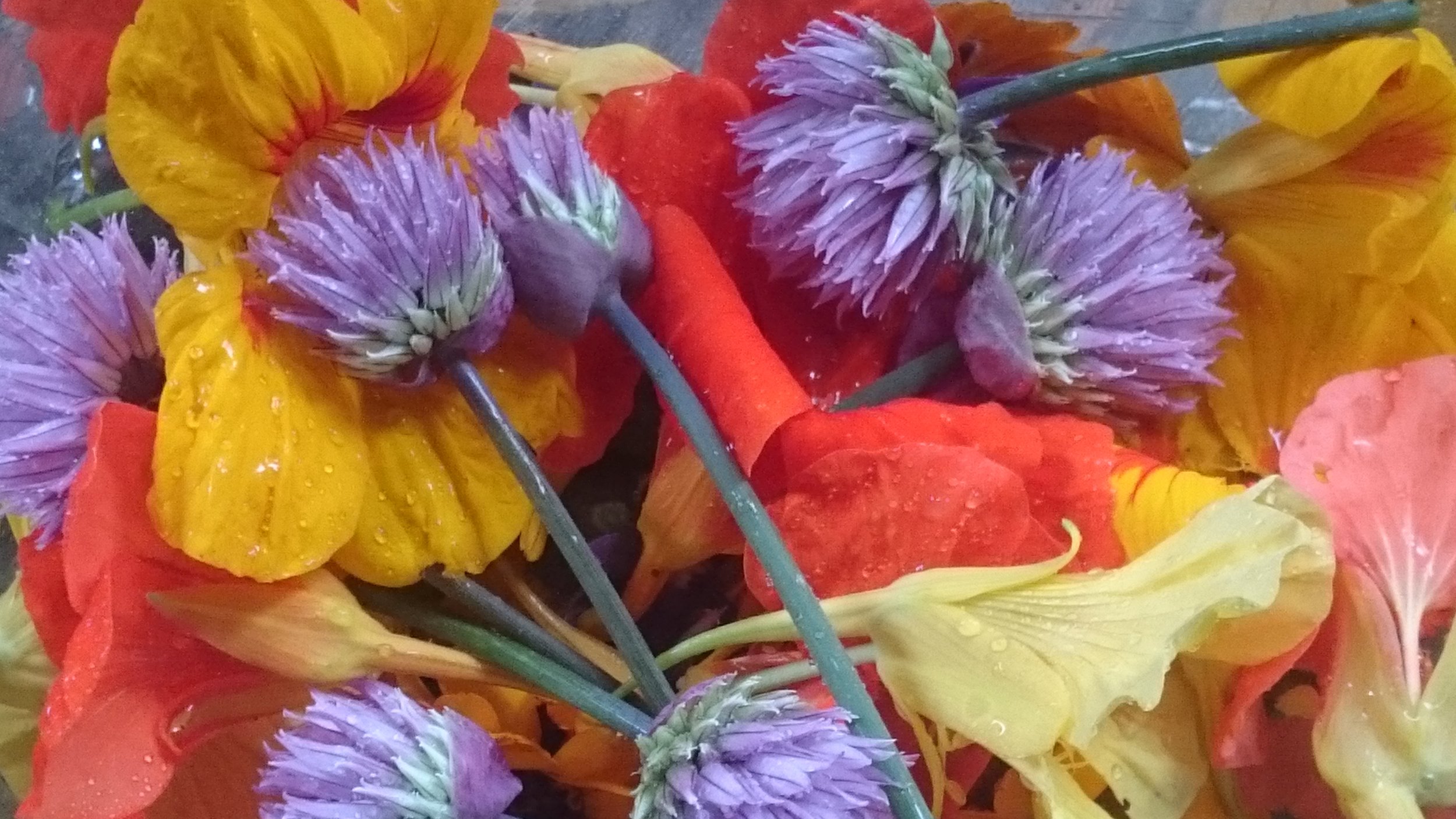 Topsy put the bread rolls into the oven and Sophie started frying the fritters in oil over the open fire. She also made a chard omelette. Emma worked with some of the group to mix fresh herbs and dressing into the potato salad, carrot and parsnip salad and green salad. We added the flowers to that and they looked beautiful.
Topsy put the bread rolls into the oven and Sophie started frying the fritters in oil over the open fire. She also made a chard omelette. Emma worked with some of the group to mix fresh herbs and dressing into the potato salad, carrot and parsnip salad and green salad. We added the flowers to that and they looked beautiful.
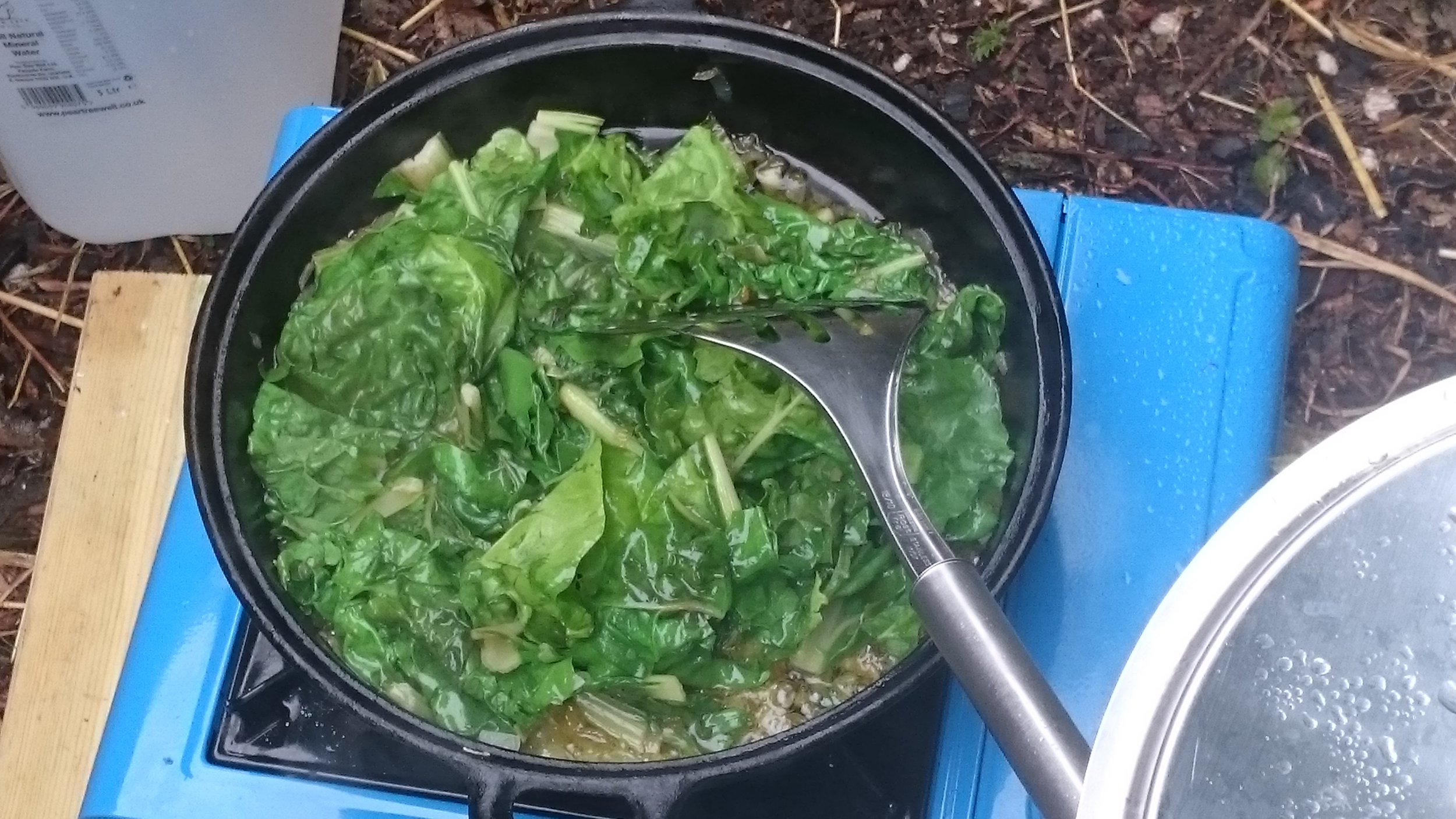
More visitors arrived. We were delighted to welcome friends and family of the St Nicholas clients, as well as other Allotment Members.
Lots of people brought food to share including a pizza pastry, a tray of wonderful cupcakes and a moist beetroot and chocolate cake.We all enjoyed our delicious shared lunch and the weather even perked up!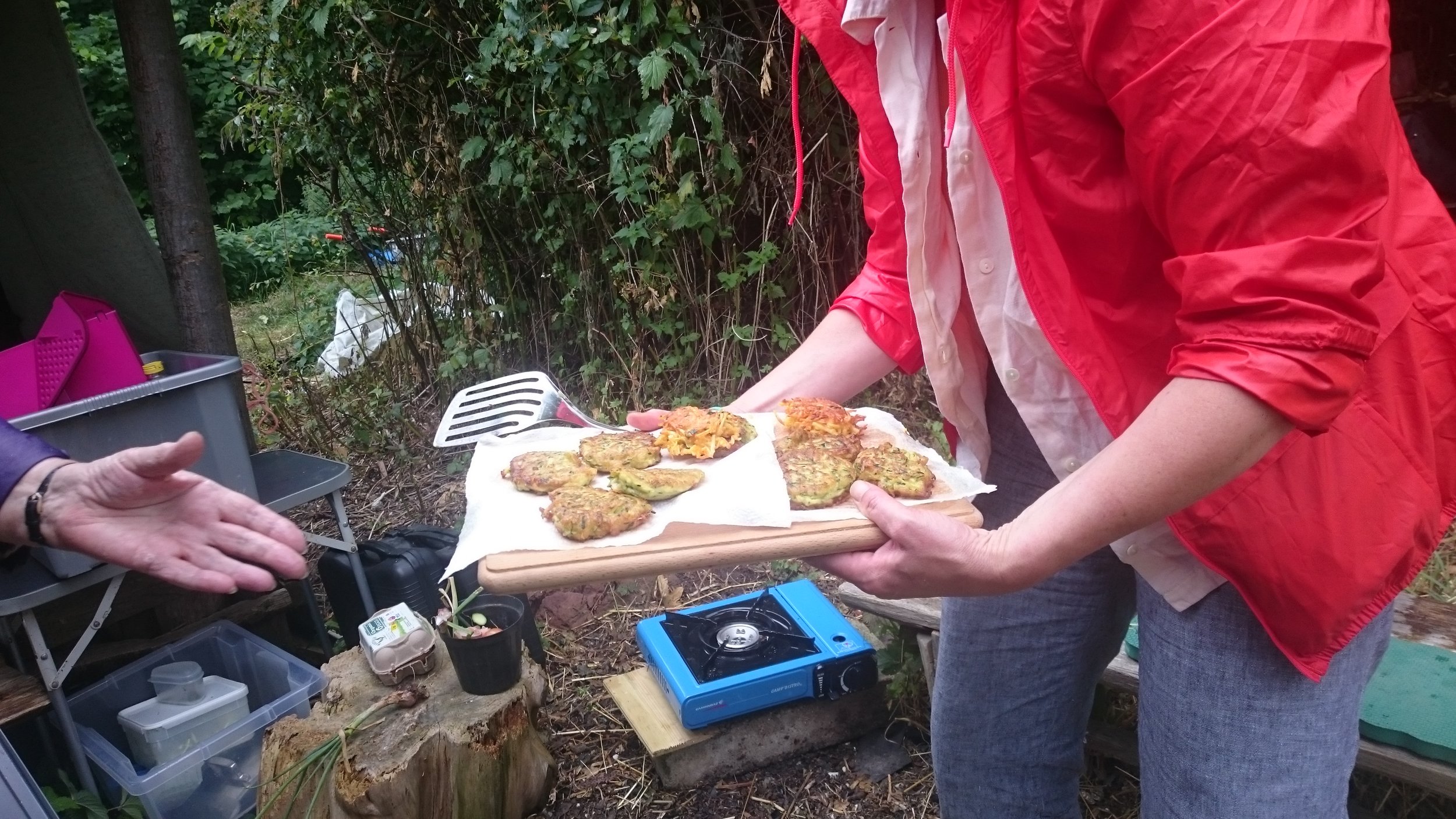
There were about twenty of us in the end. It was a lovely event, and wonderful to see everyone enjoying themselves.Thanks to Sophie for an excellent job under challenging circumstances and for some delicious food. Thanks to Topsy for excellent fire-tending, and to Sarah for organising everything. And thanks everyone who came.
Emma Chaplin, Project Manager
Read more about Flourish here
Watercolour workshop with Ruth Baker
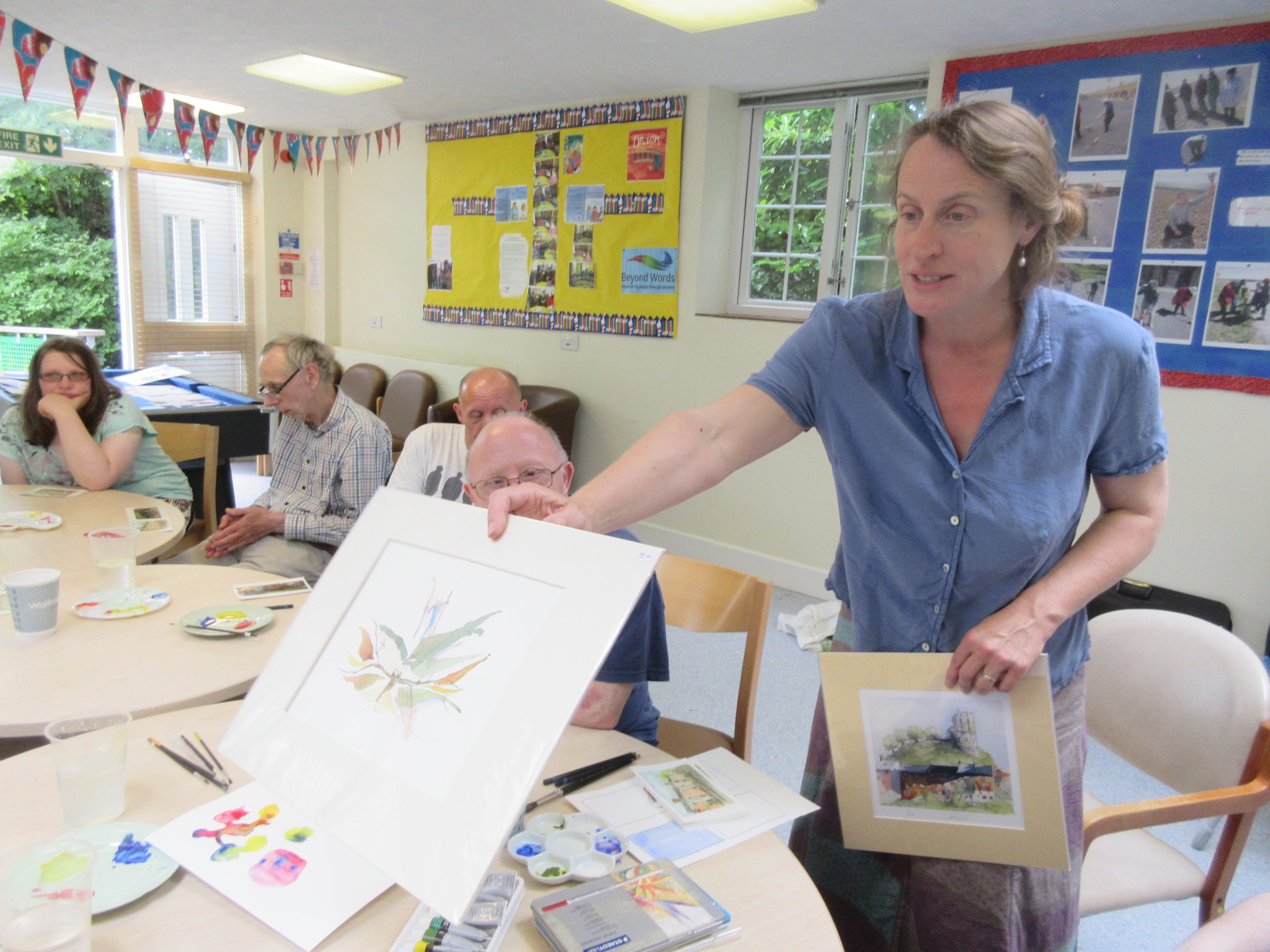 Nine regular Lewes Community Allotment clients attended a special plant and wildlife-themed art session that Flourish organised to take place on Wednesday 20 July. This was run by Ruth Baker, a local watercolour artist.
The art class was held at the St Nicholas Day Centre instead of our allotment, because of the extremely hot weather. This was useful in terms of spreading out and being able to change water frequently.
Nine regular Lewes Community Allotment clients attended a special plant and wildlife-themed art session that Flourish organised to take place on Wednesday 20 July. This was run by Ruth Baker, a local watercolour artist.
The art class was held at the St Nicholas Day Centre instead of our allotment, because of the extremely hot weather. This was useful in terms of spreading out and being able to change water frequently.
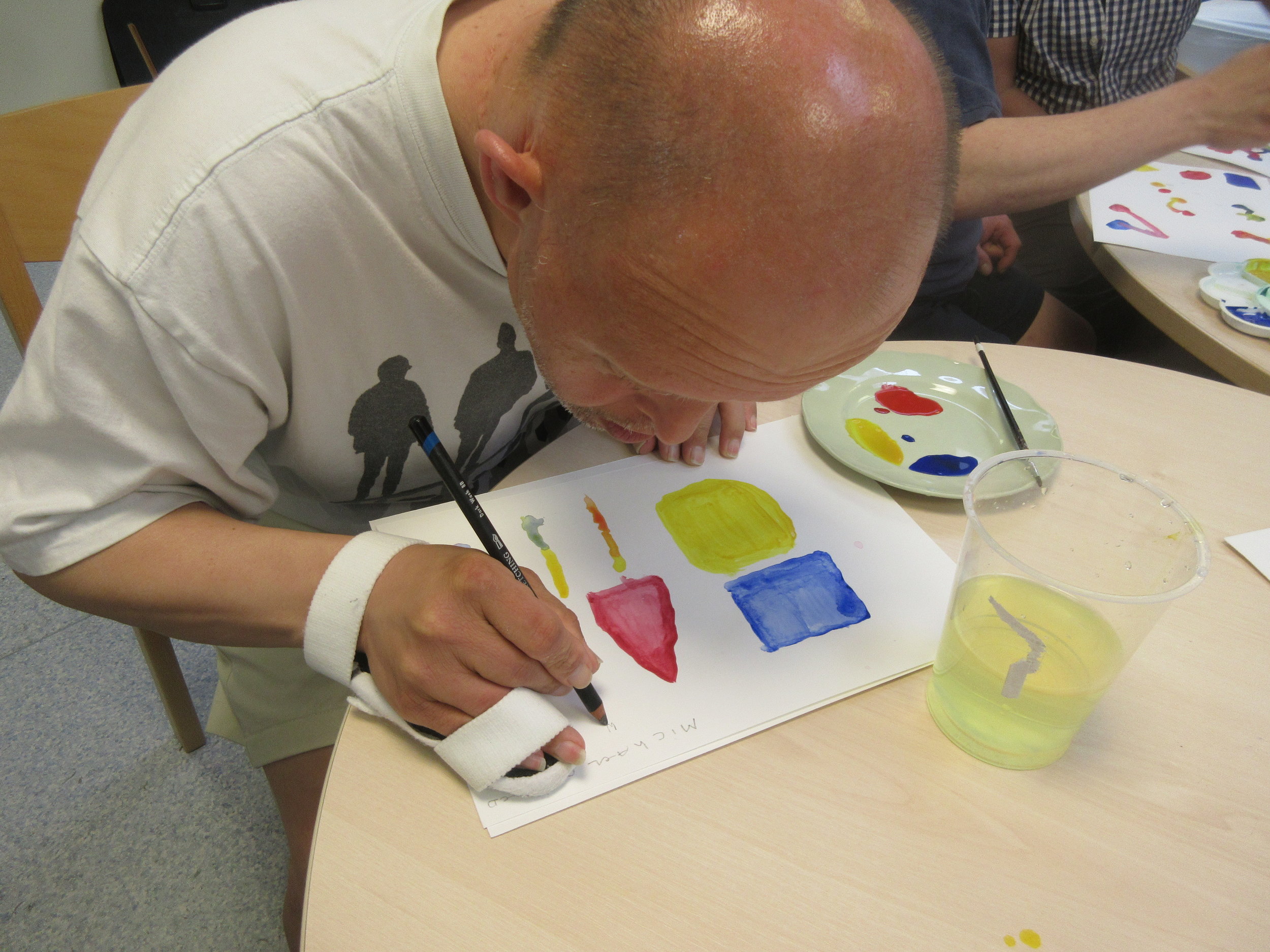
Things we learnt
Some people had tried watercolours before, but not with a trained artist.
Ruth started by explaining about the three primary colours - red, blue and yellow. Participants painted a shape of their choice in each colour, using water to add tone.
We then put dots of two primary colours next to each other and merged them to make secondary colours. All results were different depending on how much water was used, but the lovely thing was that there was no wrong results!
We used a water dropper, and people developed skills and confidence using watercolour paints and brushes.
When people felt a bit more confident about mixing the colours, we went on to paint colour was boxes and flicked red dots onto one, then drew green lines down from the dots to make simple but effective flower pictures. On the other box we painted a darker wash in a hill shape - again, all were different, but all were right, which felt good for all.
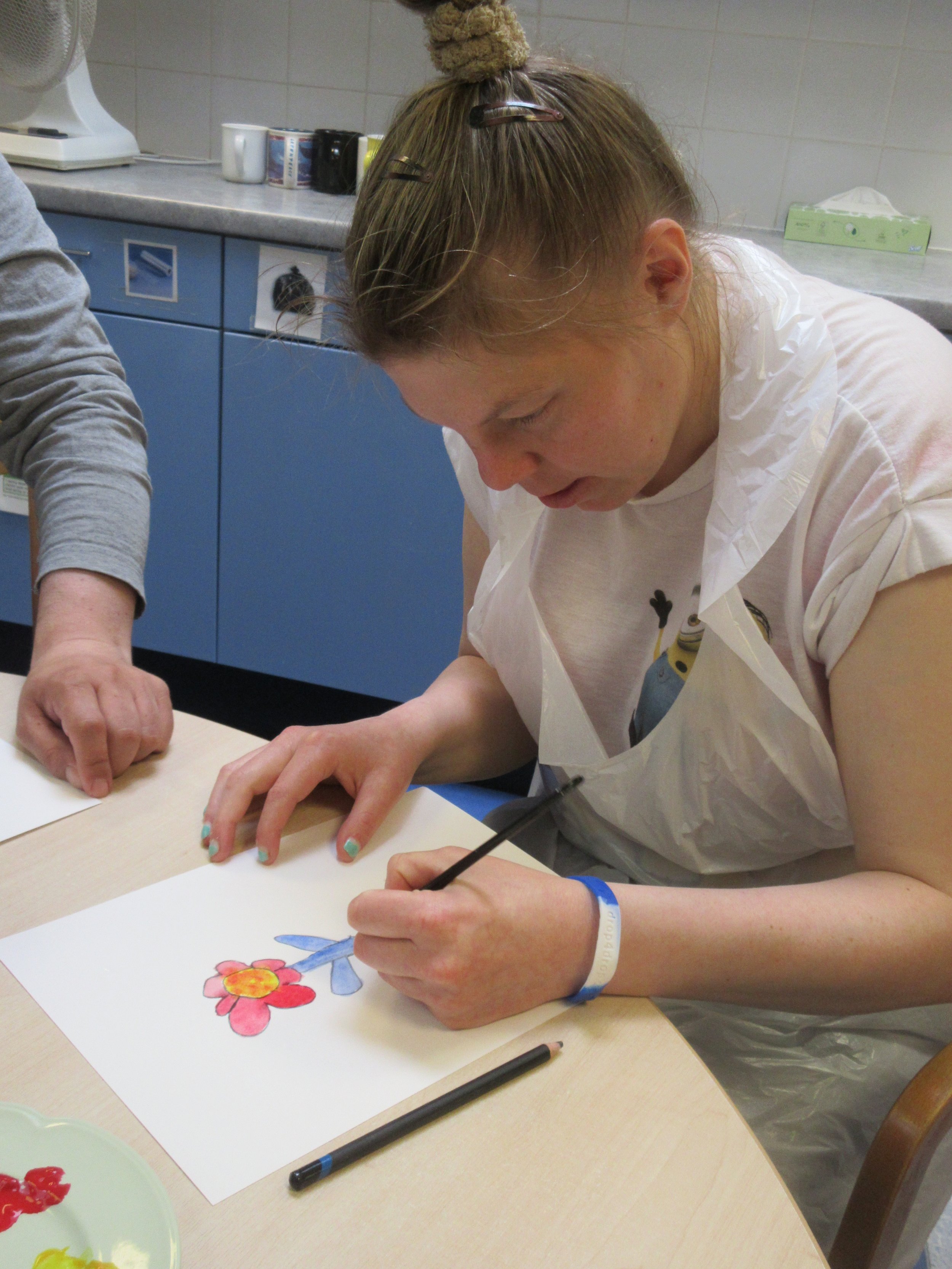
This was a very good exercise in building people’s confidence of choice (shapes, amount of colour/water, sizes) and those who were hesitant to start were much happier to put the brush to paper by the end.
People helped each other with changing water, cleaning plates, squeezing paint etc.
We went outside at break and had a look at things that could be painted another time.
Ruth spoke about her painting, how long it takes, how she sells work, showed examples and postcards, to give an insight into life as a painter.
People showed a lot of interest and asked lots of questions. Everyone enjoyed the session.
Words and photos by Sarah Rideout, Lewes Community Allotment Coordinator
Bug hunting with Michael Blencowe
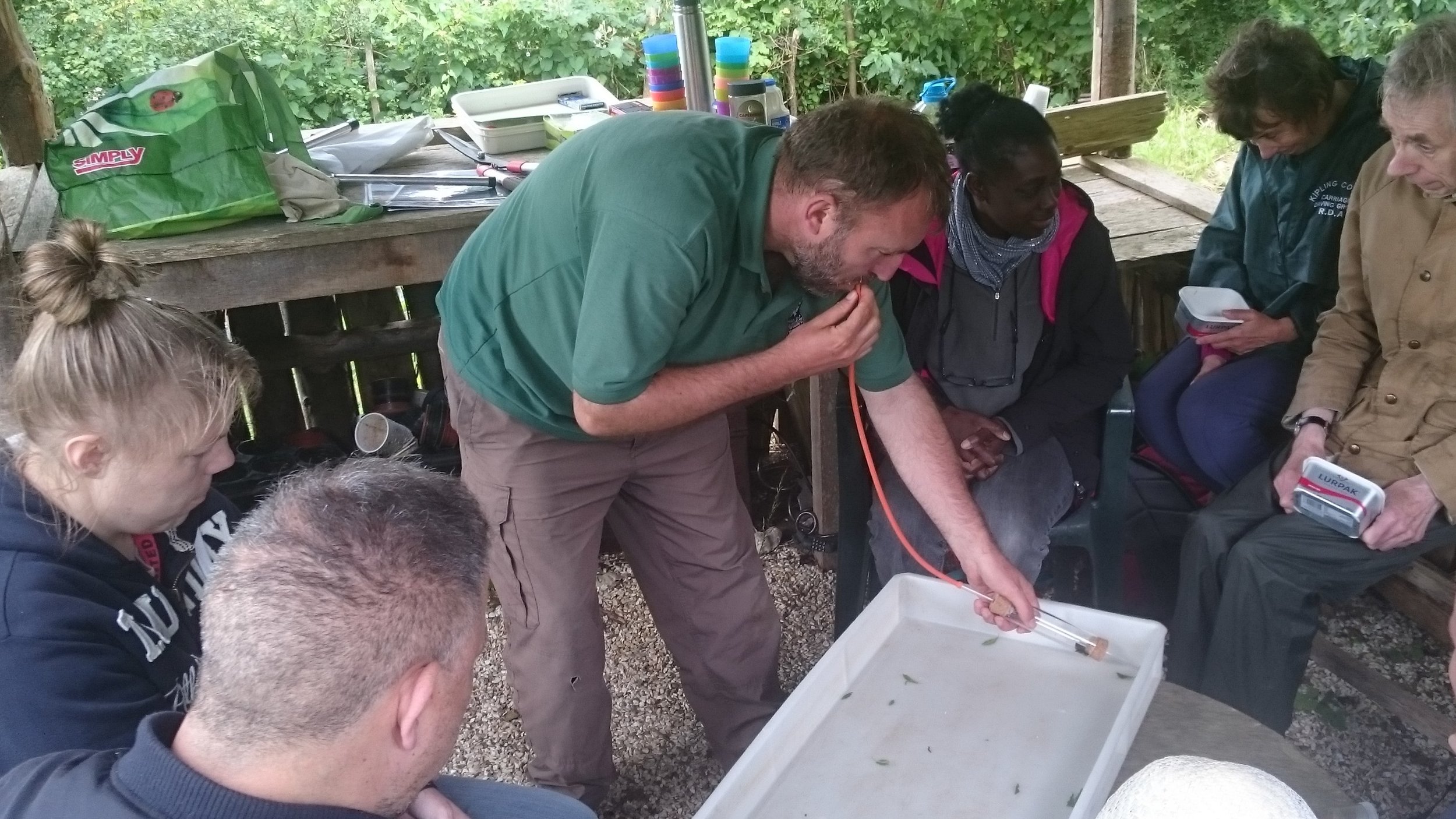 Wed 29 June 2016
Wed 29 June 2016
We had a special event for our Wednesday allotment morning group (which includes clients from the St Nicholas Day Centre in Lewes, as well as other allotment members). There were fifteen of us in total.
Community Wildlife Officer for Sussex Wildlife Michael Blencowe came along with a bag of tricks to help us hunt for and identify bugs on the allotment. He also did a walking tour looking for signs of summer, and told us a bit about his job.
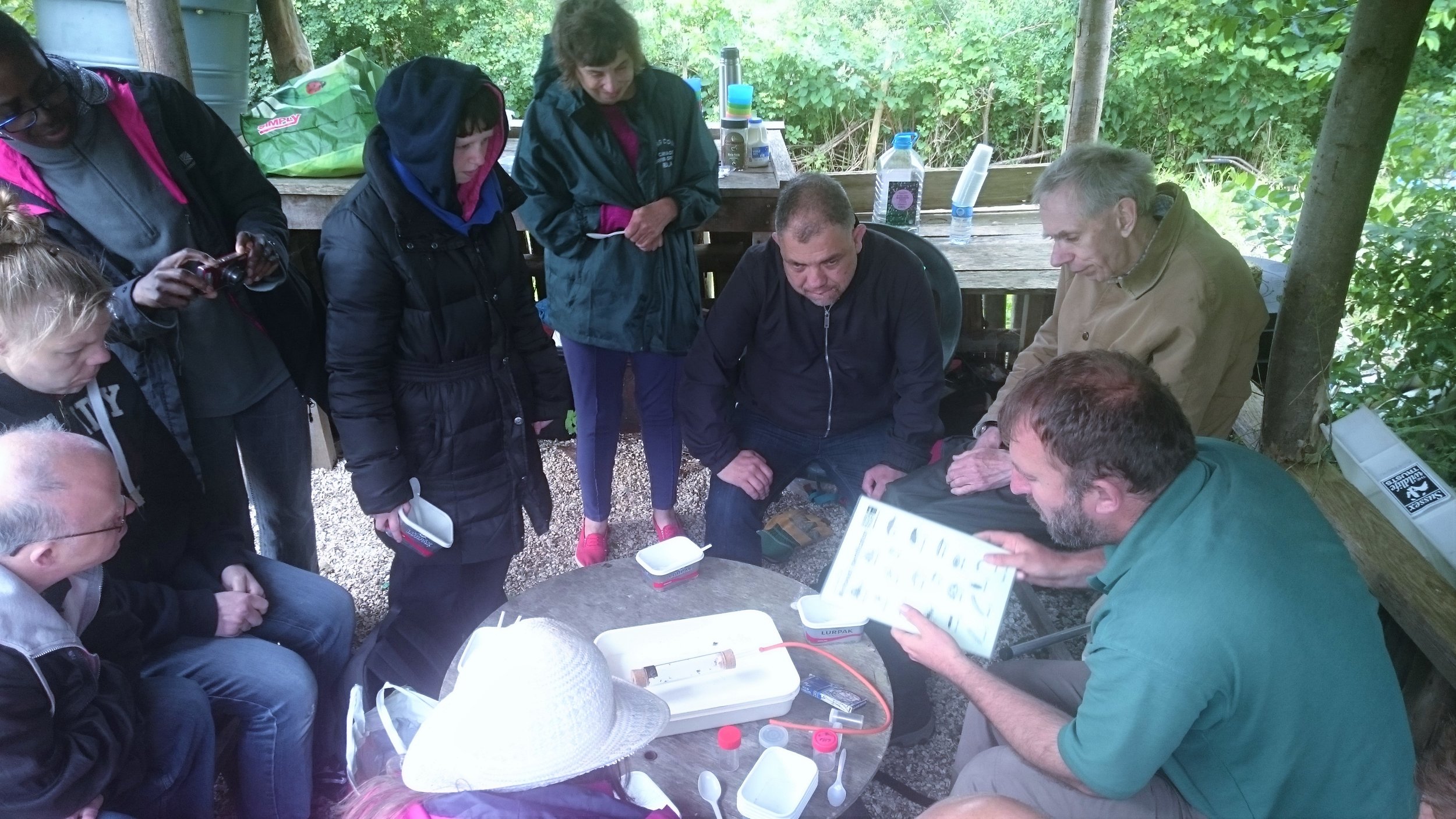 Michael's Talk
Michael's Talk
First, Michael told the group about the history of the landscape around us, how the South Downs came to be as we know them now, with the variety of wildlife that we now have. Grazing sheep have played a part in it - but millions of years ago, Lewes was under the sea. The chalk under our feet is made up of the crushed bones of long-dead animals - including dinosaurs. He showed us pictures to help us understand.
Bug Hunting
Because this was a summer visit to our allotment, Michael said he had hoped to show us butterflies and hoverflies - but the cold, breezy weather meant there weren't many to be seen.
Michael gave out plastic tubs and spoons to everyone to pick up insects. He also showed us about his new toy, a glass tube or 'pooter' he had brought along for sucking up bugs for us to examine. We all felt a bit horrified at the idea of sucking up a bug and swallowing it, but he said that didn't happen :).
He talked about different habitats for insects - there are lot of insects in long grass, and in the nettles. He had a net he wafted in the long grass to collect insects.
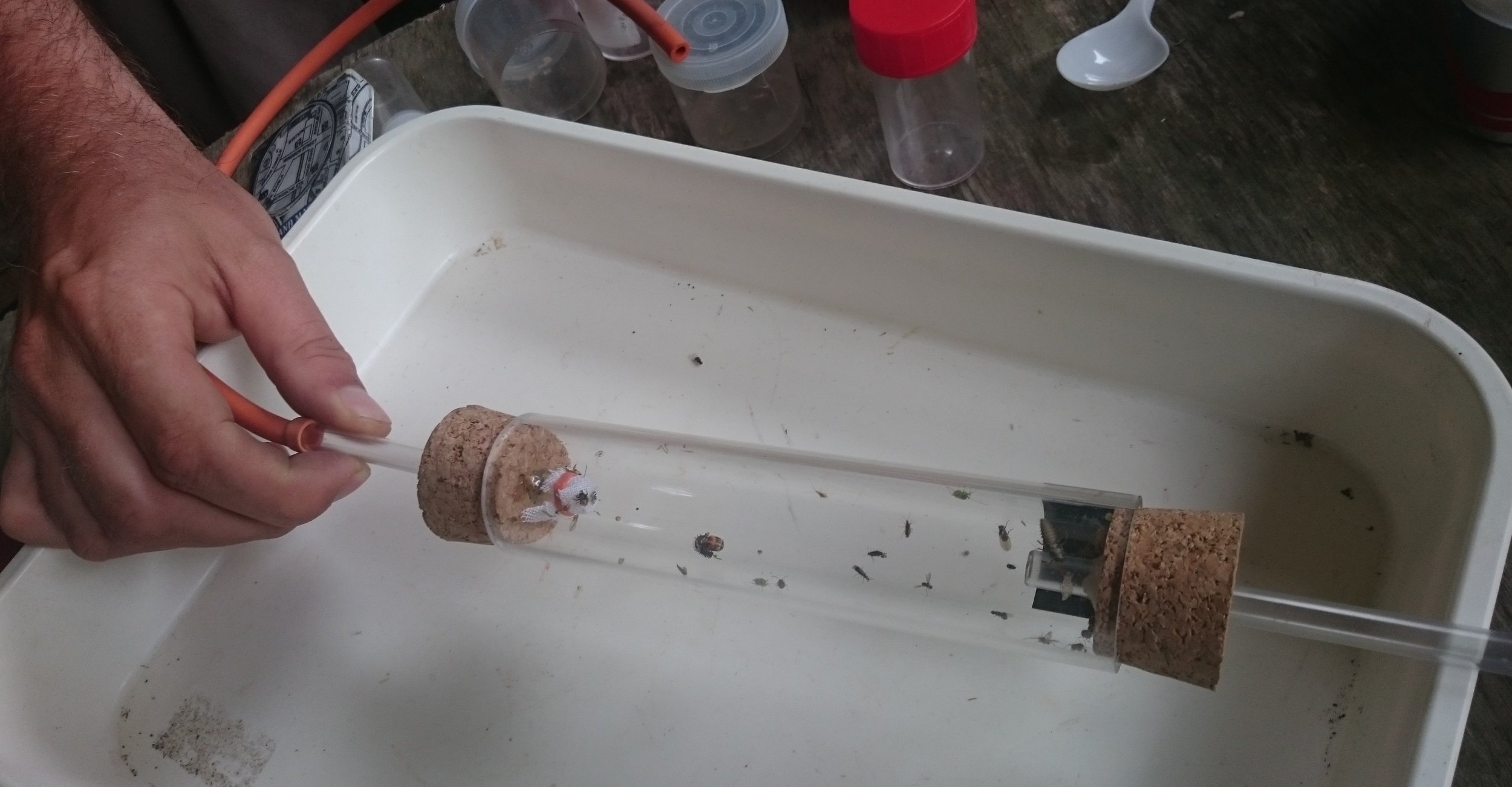
These he tipped into a white tray on the table in the shelter, and everyone picked the bugs he'd caught with their spoons and put them in their tubs. Michael then sucked them up in his pooter so we could identify them. We saw a hopper (Michael explained how amazingly far they hop - if we could do the same, we could hop from the allotment to Lewes!), wood lice, flies and a brown-lipped snail.
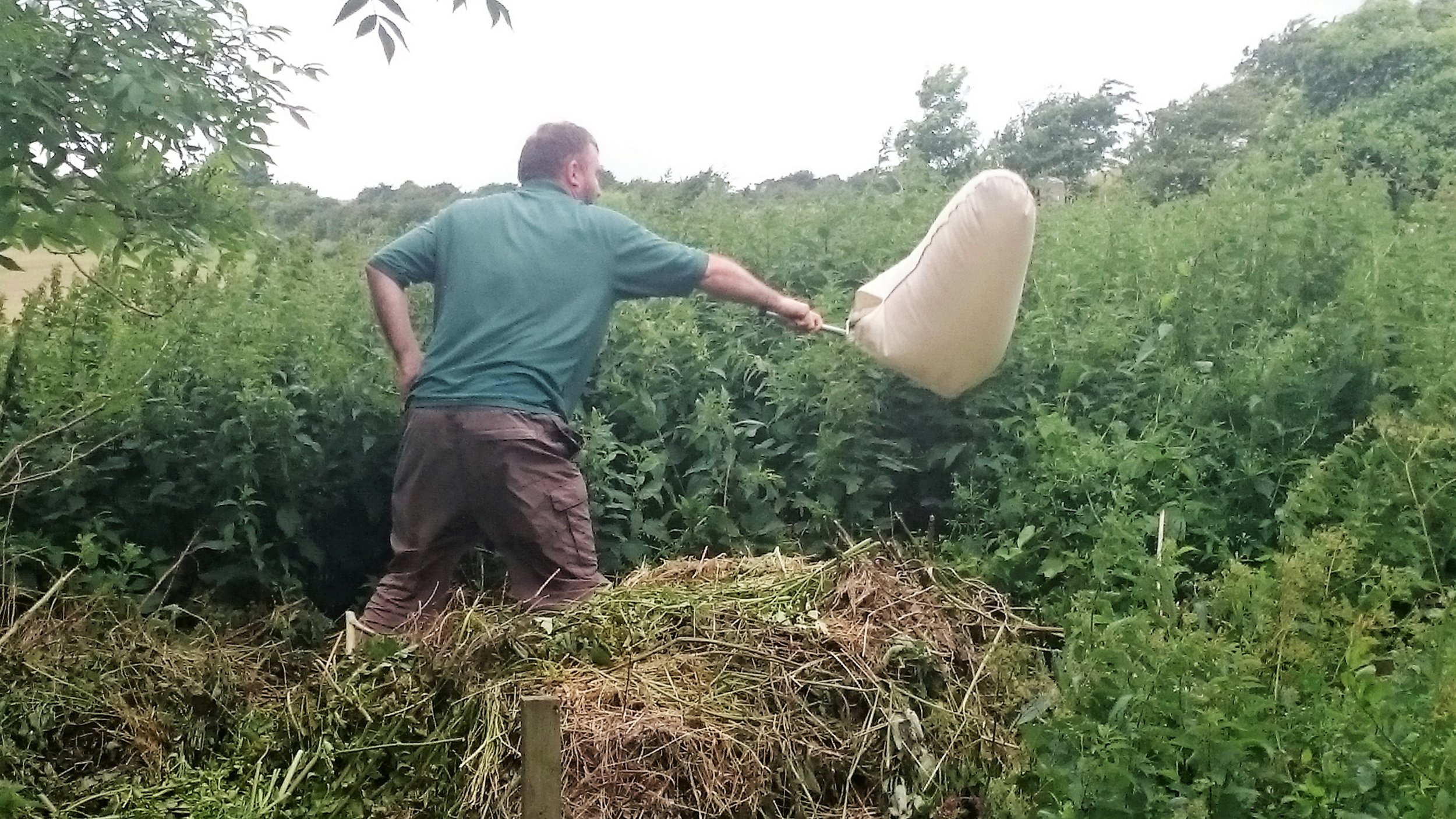
Rather to our surprise, Michael leapt onto the compost heap and wafted his net in the nettle bush behind. The bugs he caught, he then tipped into a tray in the shelter. Everyone scooped them into their tubs and he sucked them up again in the pooter. We saw an ant, flies, and more snails.
Michael showed us what he explained was another new toy - a fold-out 'beating net' - which looked like a big, square umbrella.We pretended it WAS an umbrella for this photo: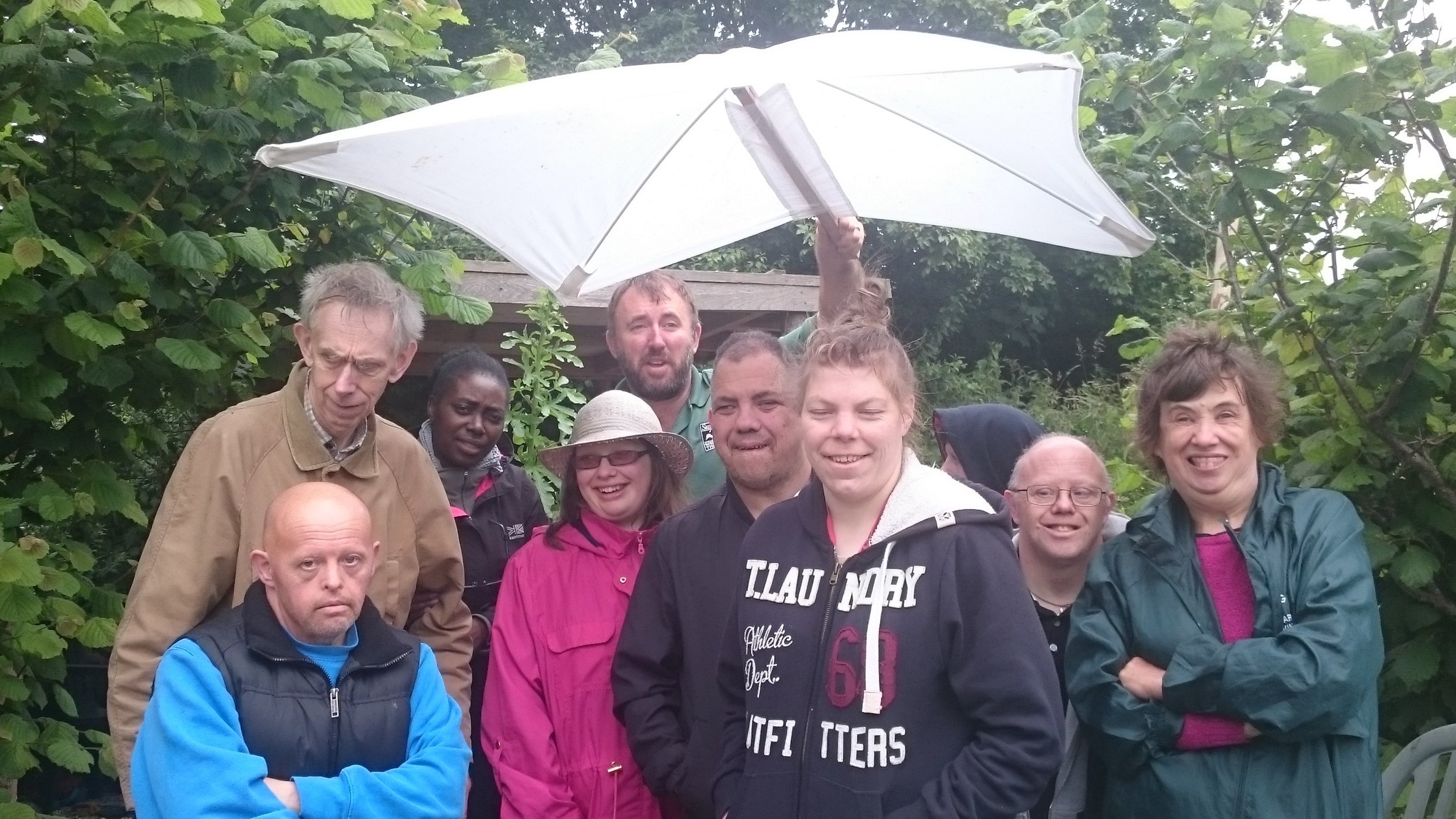
The beating net is for finding insects who live on leaves in the trees. He held it up under a tree, banged the branches, and various insects fell into the net.
He then tipped these into the tray for identification as before. We spotted a young harlequin ladybird and a pupating ladybird, some beetles, plus some flies.
Michael answered questions anyone in the group had.
We then released all the bugs we'd caught.
Signs of Summer
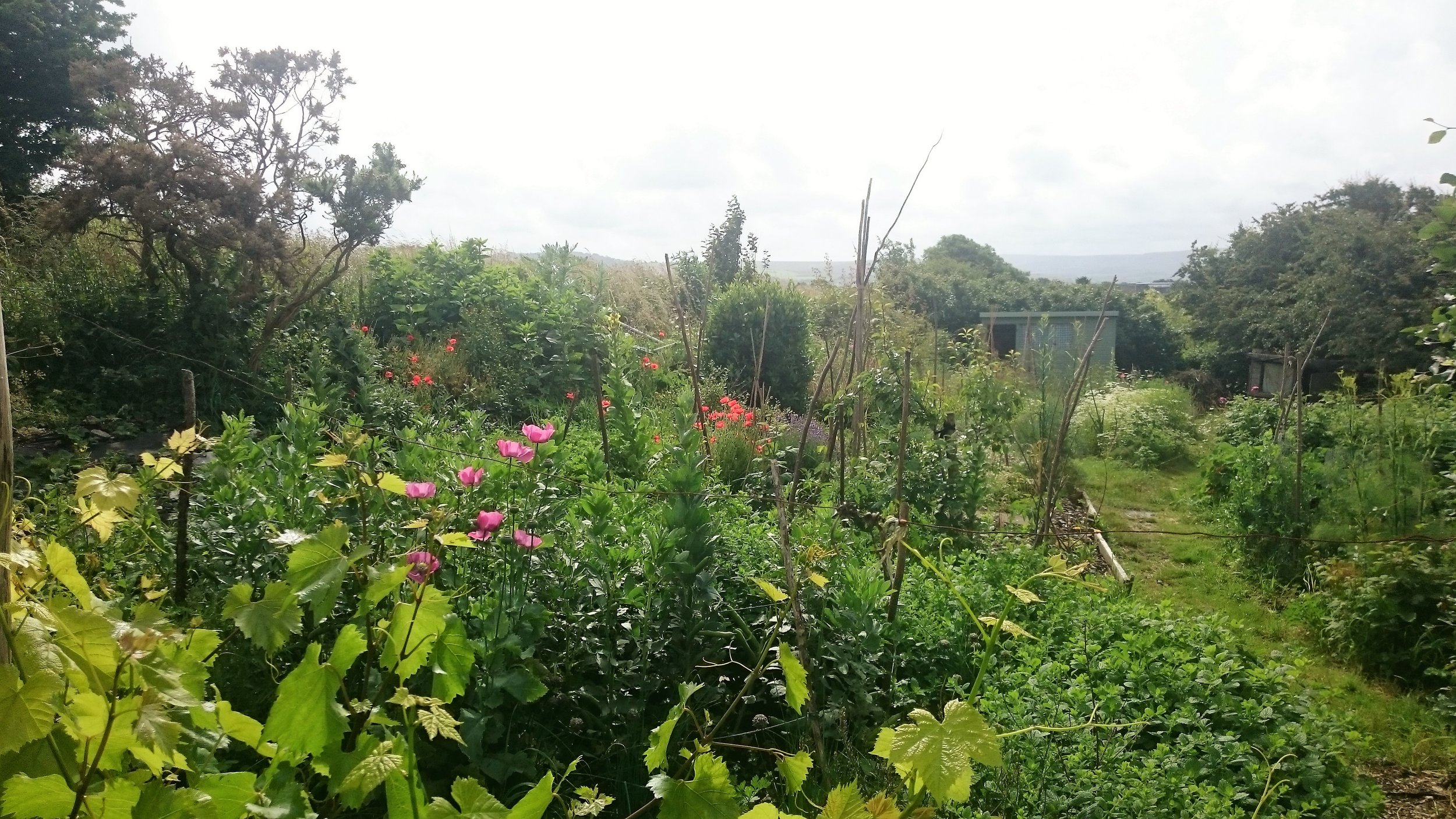
Then we did a walk around the allotment to look for signs of summer. Michael admired our new lovely new shed.
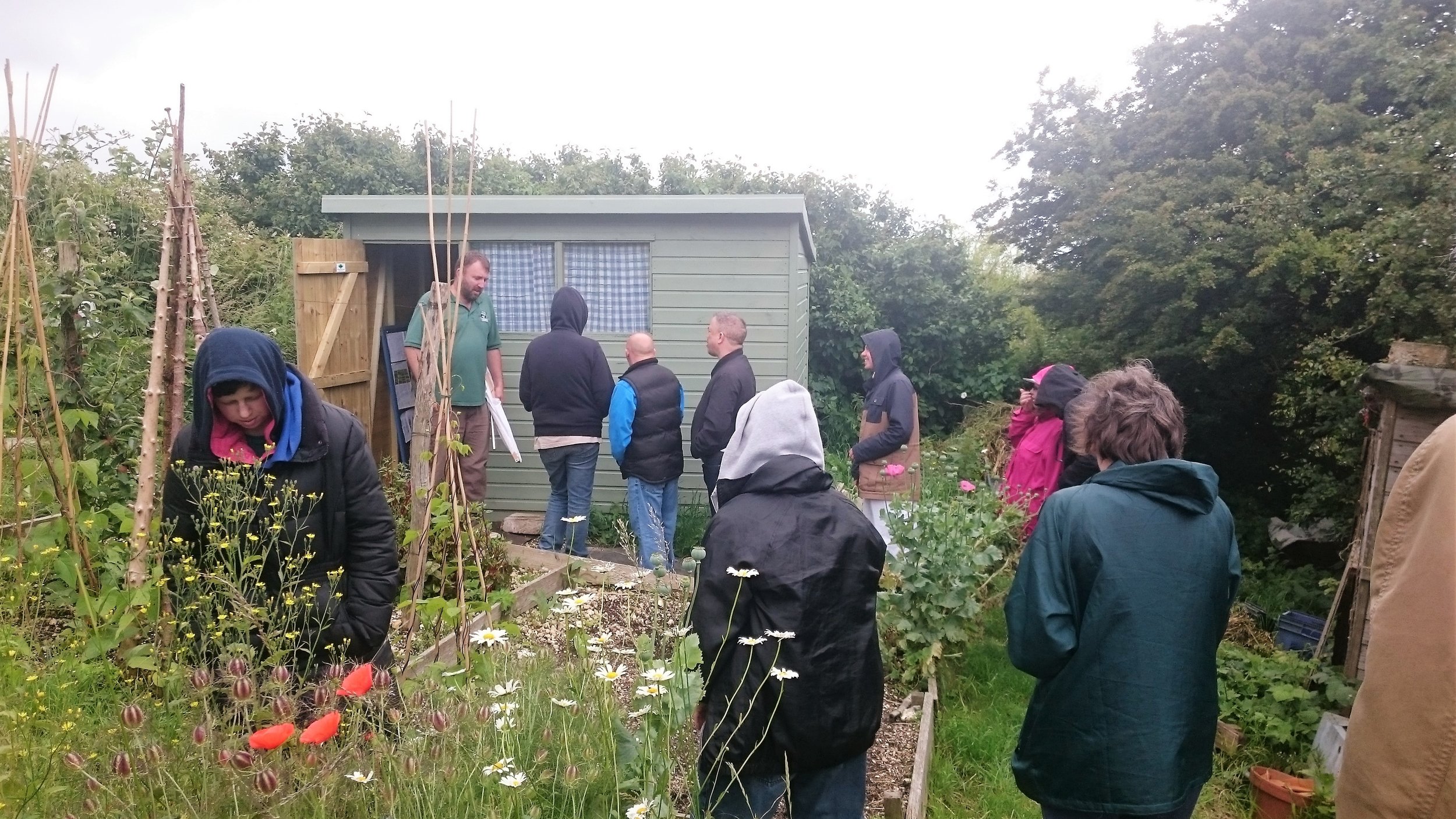
The signs of summer that we all spotted and recorded on our walk were:
- Lots of flowers blooming, including marigolds, poppies, lavender, fox gloves and ox-eye daisies. Allotment members Felicity Ann and Susannah helped us identify some of those
- We saw some bees buzzing around the flowers, and Michael told us that bees waggle their bums to keep warm when it's cold
- We saw and identified different fruit that is not yet ripe - including apples, gooseberries, redcurrants, raspberries and strawberries
- We saw and identified shallots, peas and broad beans
- We saw and heard some birds and Michael talked about how some birds come from below the equator in the summer in search of a warmer climate with insects to eat. They fly thousands of miles.
- We saw an ants nest - yellow meadow ants - and Michael told us that ants move their eggs into the sun to keep them warm - when there IS sun
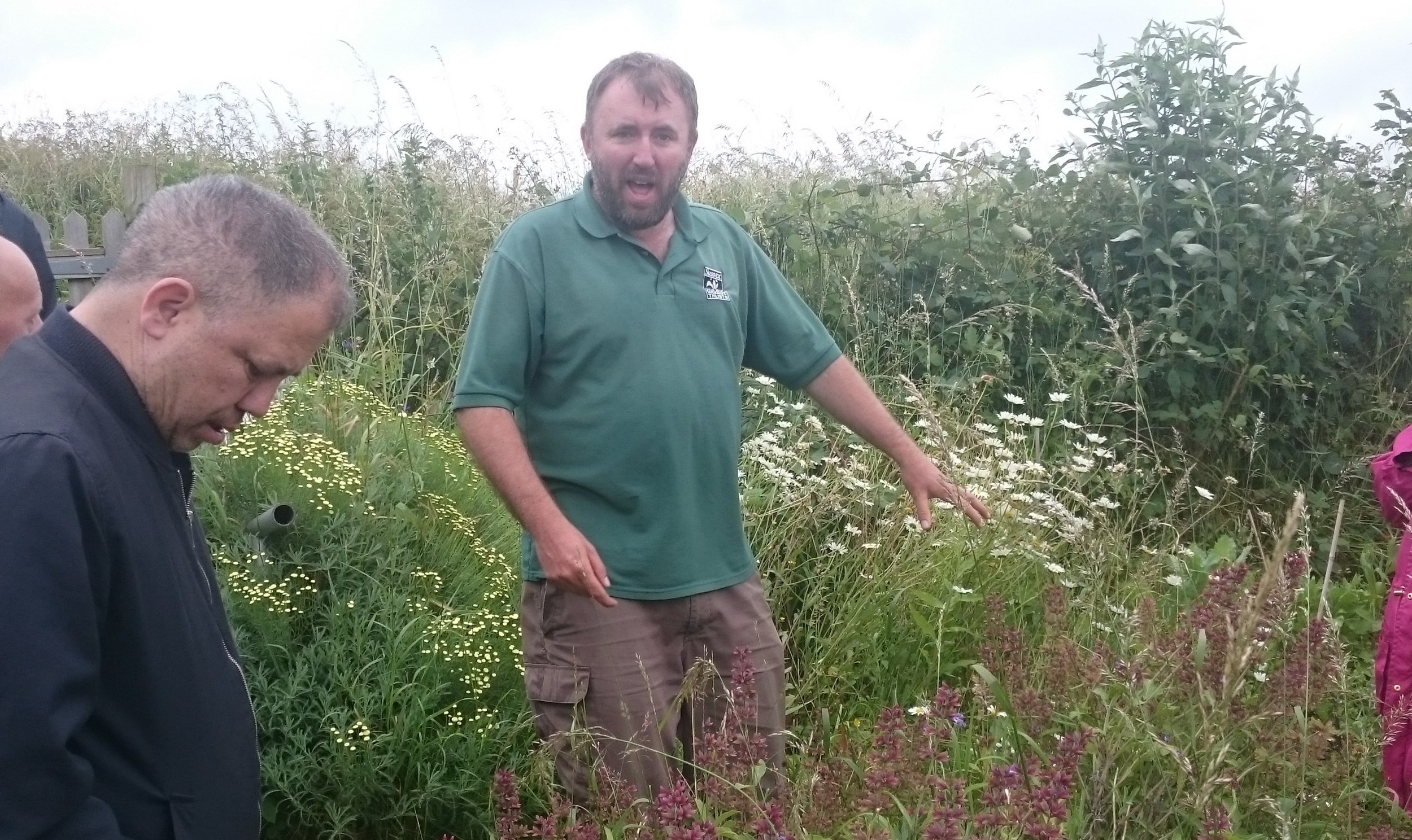
Being a Community Wildlife Officer
Then we went back to the covered shelter for a drink.
Michael talked a little about his job and what he likes about it. He said:
"To do my job I need to be able to engage with different sorts of people, children and adults. As a little boy, I spent lots of time in the wild. You have to like working outdoors - there is a lot of walking - which keeps you fit - but you have to like that."
Michael said he doesn't work alone, he sometimes works with Park Rangers and National Park Rangers, which he enjoys.
What We Learnt
New shed at Lewes Community Allotment
Much as we've loved our old shed, it's very old and getting past its prime, so the great news is that we've been putting up a new shed at our allotment, which is going to be brilliant. We've grateful to Lewes Town Council for their support with this. Here it is going up last week
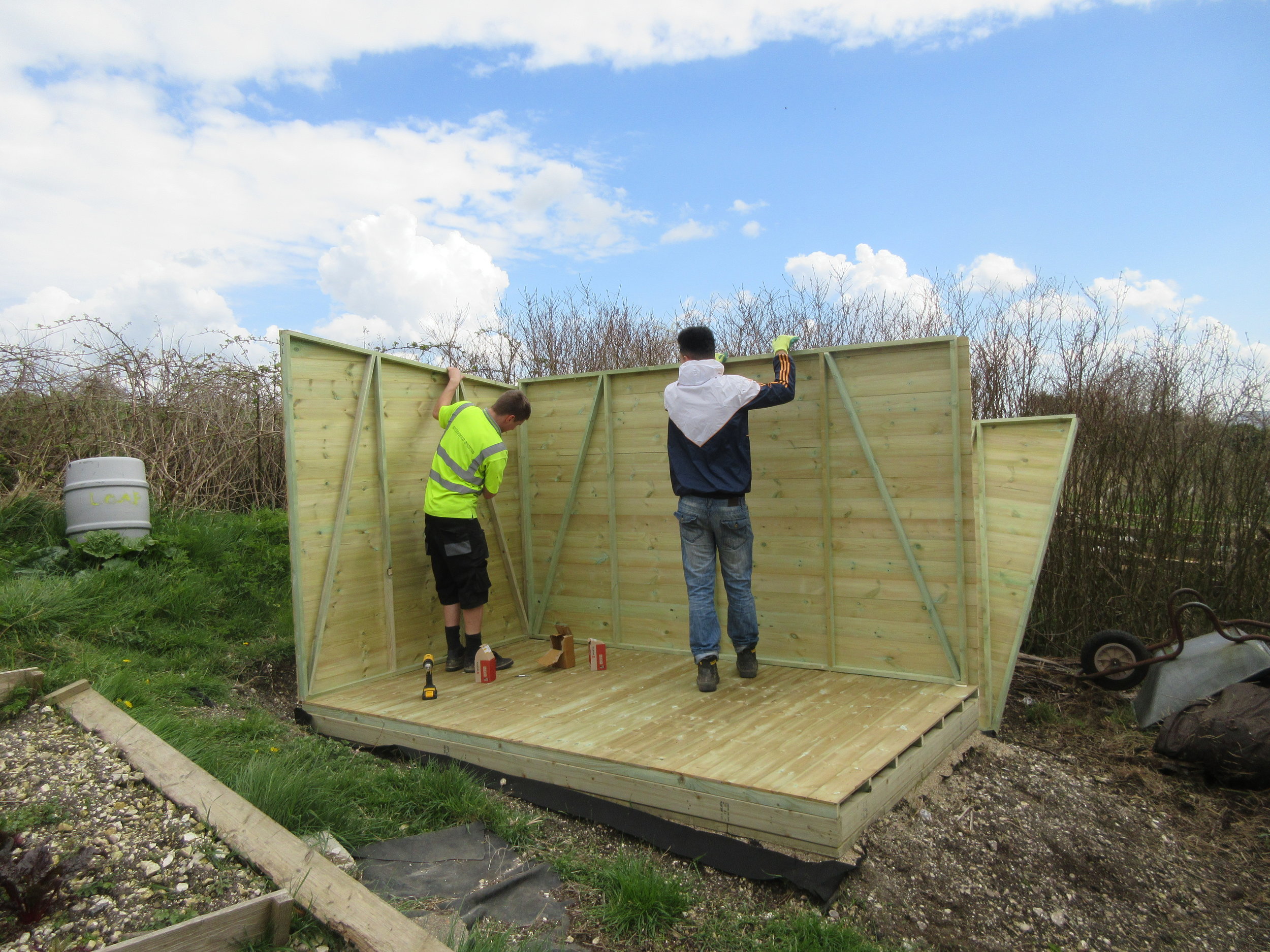
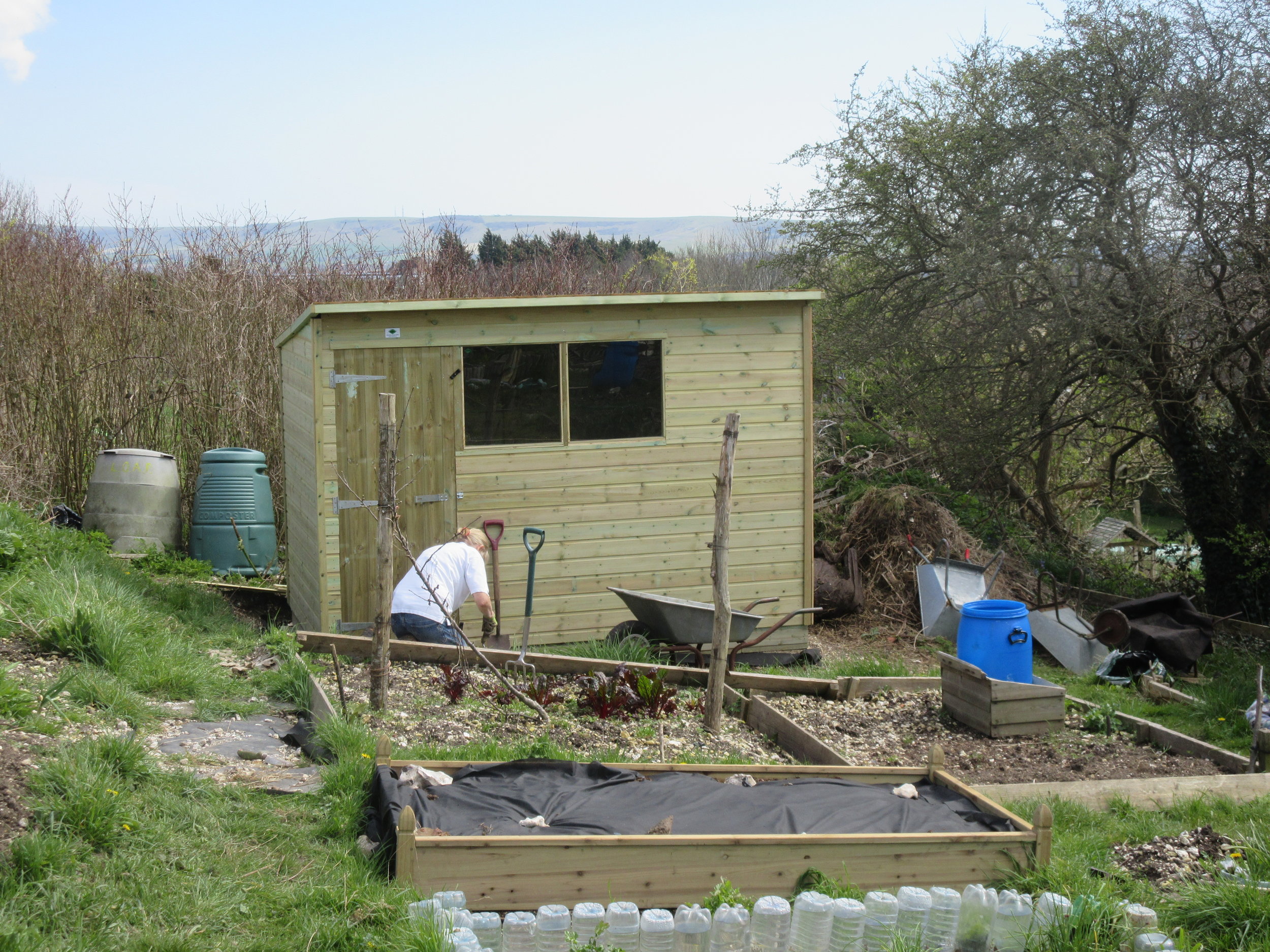
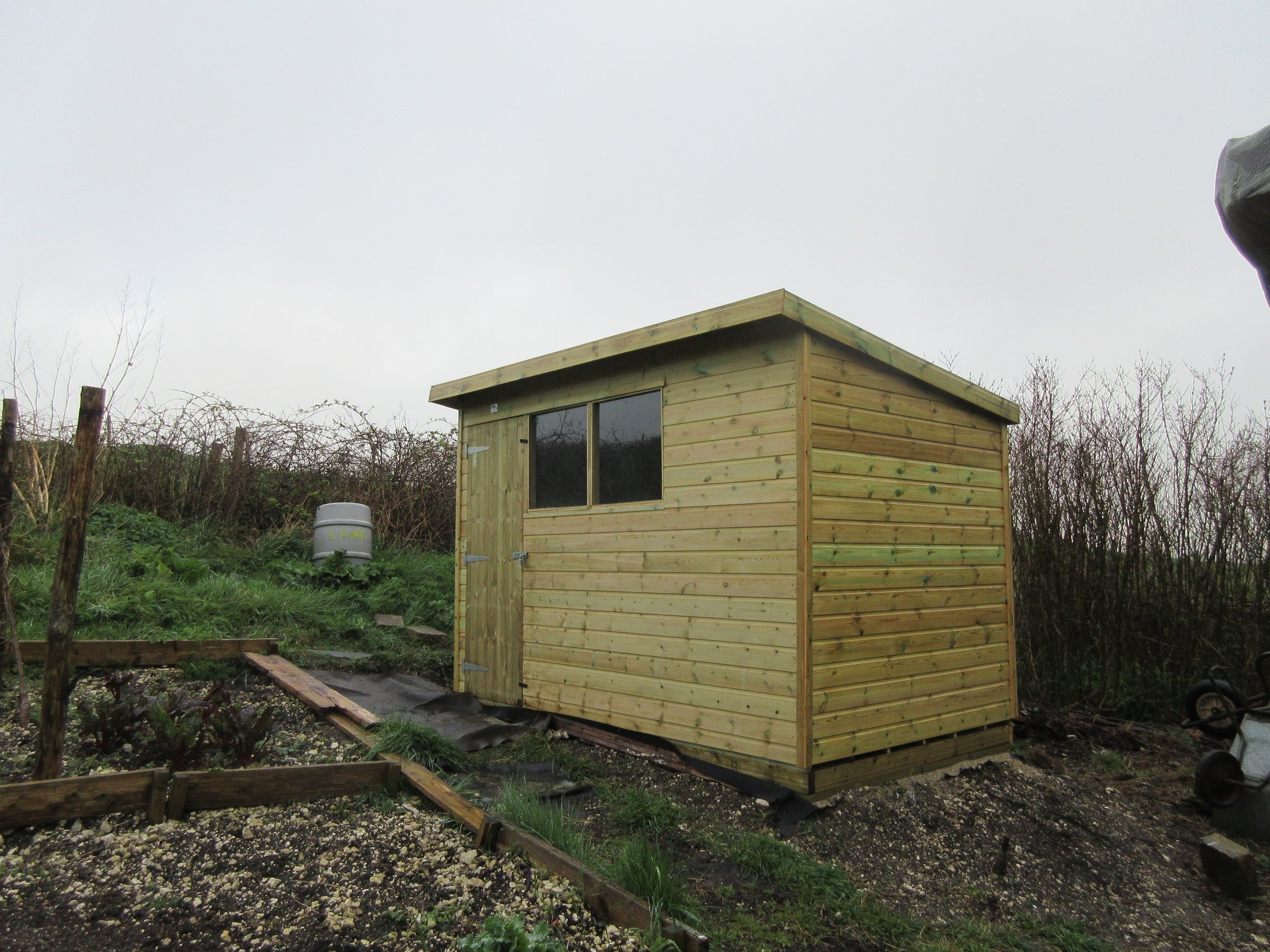
Open Events - come & meet us!
If you're interested in finding out more about what we do, we will be running a number of open events over the next few months.
Drop-in sessions at Baulcombes Barn
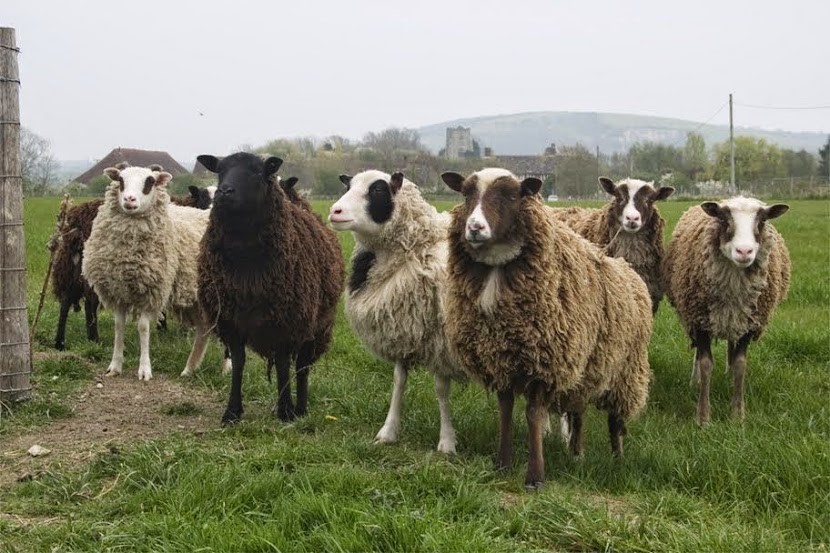
Farmer and therapist Owena Lewis will be offering taster sessions on her smallholding at Hamsey.
If you might be interested, drop Emma an email flourishlewes@gmail.com
Lewes Community Allotment Open Drop-in Sessions
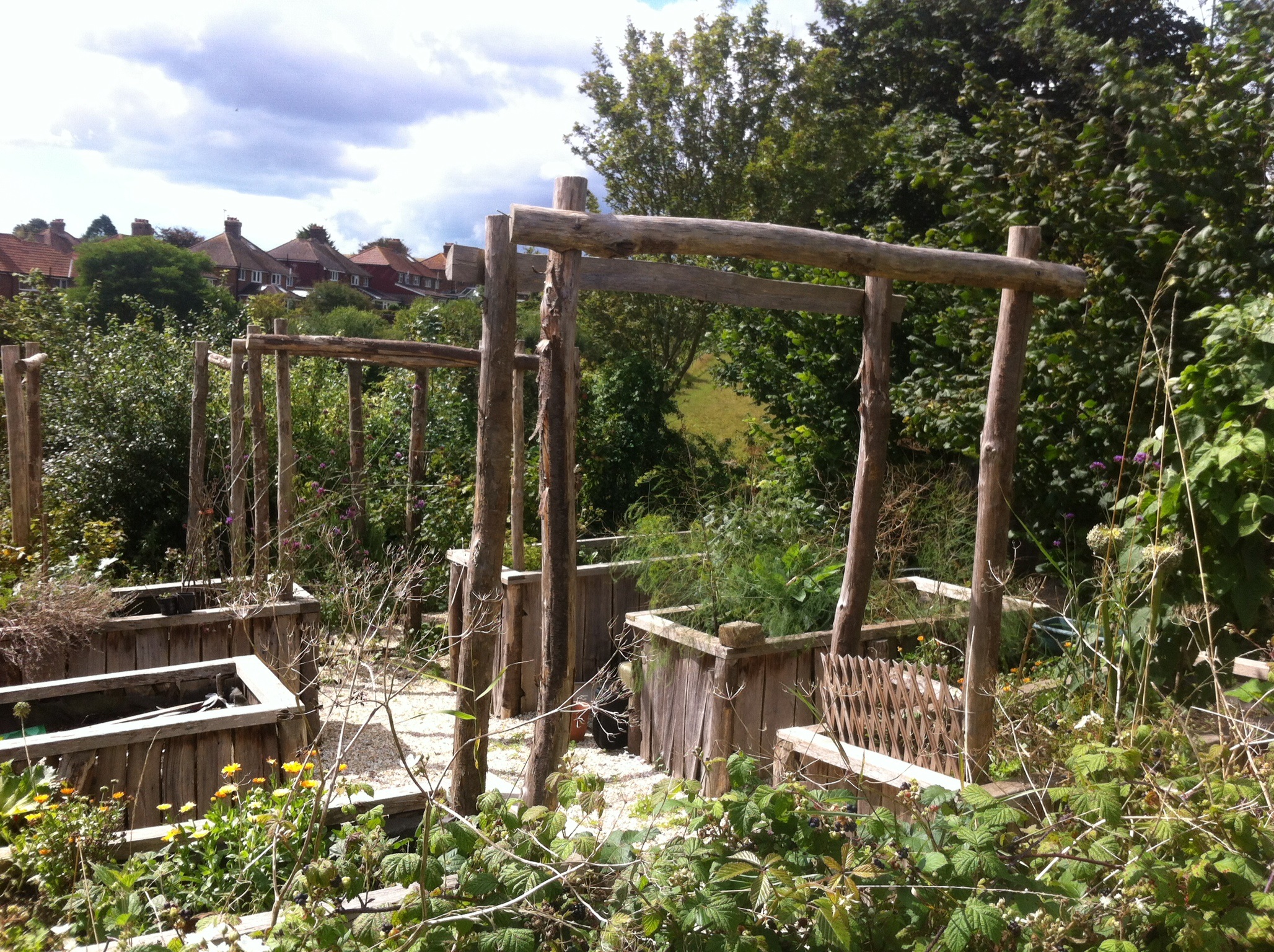
Our regular open sessions at the Lewes Community Allotment take place on the last Saturday of every month from 2-4pm, from March-November. We're based up the Nevill.
Meet co-ordinator Sarah Rideout, have a tour of the allotment, see if you might be interested in coming along regularly to spend some time outside, learning about gardening and growing food in good company.
Contact Sarah on flourishloap@gmail.com
LOAP allotment planning meeting 2016
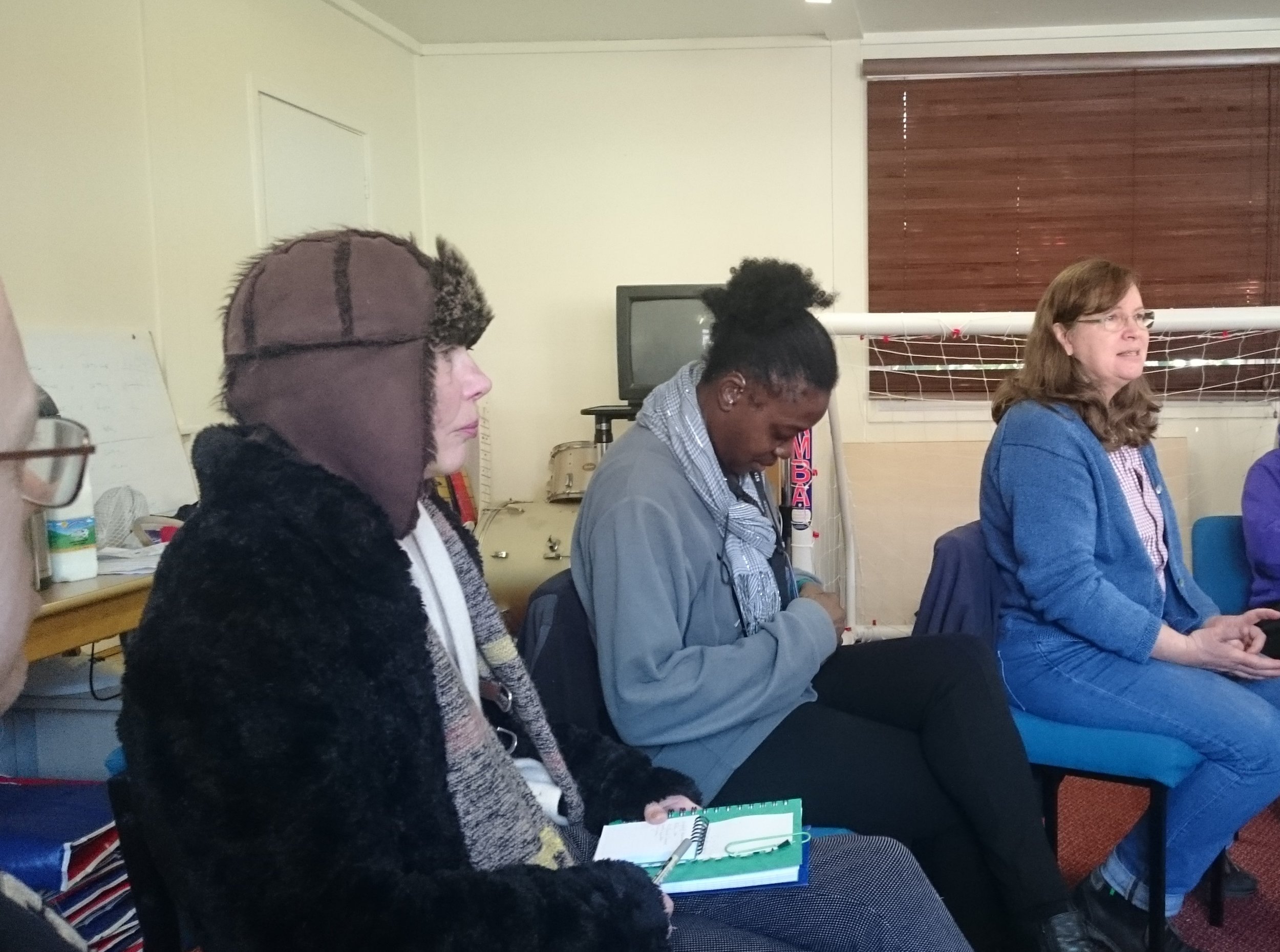 Around 20 LOAP members came along to the Sanctuary at the St Nicholas Day Centre for an allotment planning meeting on 3 February 2016 to discuss what to plant this year.
LOAP co-ordinator Sarah Rideout facilitated the session, and also present were St Nick's support worker Bisi Alaba and Flourish project manager Emma Chaplin.
Around 20 LOAP members came along to the Sanctuary at the St Nicholas Day Centre for an allotment planning meeting on 3 February 2016 to discuss what to plant this year.
LOAP co-ordinator Sarah Rideout facilitated the session, and also present were St Nick's support worker Bisi Alaba and Flourish project manager Emma Chaplin.
Sarah began by explaining that the purpose of the meeting was to look at what to grow and do at the allotment during 2016.
She said the best way to do that would be to discuss what had grown well in the last year at the allotment, think about what didn't do so well and why, which would help everyone to think about what they'd like to be grown on the allotment this year.
She had brought along a large box of seeds and seed catalogues for people to look at, as well as planning plans to be completed.

Sarah also had some big sheets pinned up with pictures showing possible special session ideas (willow weaving, bird box making, bee-keeping, storytelling, mosaics, outdoor cooking, manual handling and food hygiene) so everyone could let her know what they found most interesting.
Emma spoke to the group briefly as a reminder of what Flourish is, and how the different parts of Flourish (Baulcombes Barn and Ringmer Community Orchard) all fit together. She had brought along some leaflets and photos. She mentioned the Project User Group, mentioned that met for the first time before Christmas, and told everyone the next meeting will be held at LOAP in March. She hopes lots of LOAP members will come along to it to meet other project users.
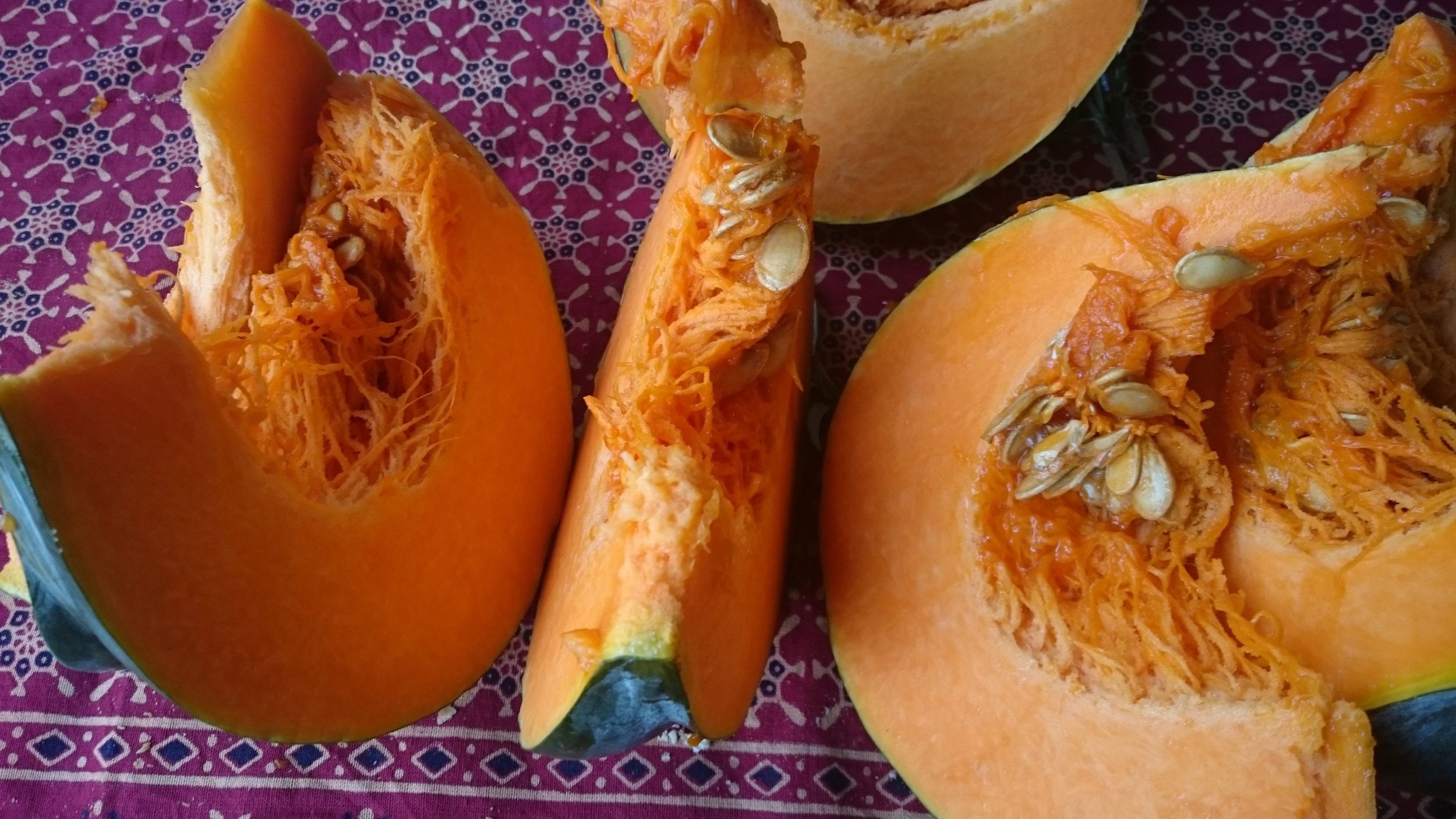 What grew well this year
What grew well this year
Pumpkin - although best not orange, they can get stolen before Halloween.
Big red beetroot and leeks. Garlic. Chard. Perpetual spinach. Carrots.
Mizuna. Corn salad. Achocha. Tomatoes (before blight arrived).
Herbs around bed edges. Soil improvement - compost and manure.
What didn't grow so well this year (and why)
Tomatoes - too close to each other?
Structures a bit rickety, could be better
Beans - not many
Radish and strawberries - problems with lots of woodlice
Need more pest protection and successional sowing (peas, salads)
What people want to grow this year

Veg
Easier:
Garlic, carrots, purple ones (heritage seed). Shallots and or red onions, spring onions, salad potatoes, spring and other cabbage, non orange pumpkins, squashes, pattypans, peas, tomatoes (plum, cherry), courgettes, cucumber, spring greens, parsnips, perpetual spinach, chard, celeriac, mizuna, purple frilly brussels sprouts, kales, salad leaves, land cress, pak choi, rocket.
Harder:
Sweet potato, asparagus, aubergine, kohl rabi, chilli peppers.
Fruit
Grapes, plums, strawberries, cherries.
Flowers
More edible flowers - nasturtiums, marigolds, borage, violas etc. Water iris, sweet peas, poppies, sunflowers (multi-head and red), bee and butterfly flowers, cottage garden flowers.
Herbs
Plants to make tea eg chamomile, lemon balm, peppermint etc.
Chives, parsley, thyme, more herb bed edges.
Companion planting, dandelions, milk thistle, calendula.
In general - fewer potatoes and onions as these don't cost much in the shops.
Extra activities feedback:
Topic and Number of votes
Story telling 6
Outdoor cooking (bread oven) 9
Hazel weaving 6
Making bird boxes 7
Making mosaics 7
Bee-keeping 3
Safe lifting/manual handling and food hygiene, with certificates 12
Extra suggestions (that incur costs):
Making a book that we could all design - recipes (some gluten free), photos and drawings of allotment, done by St Nicks group (or all)Extra suggestions (that would need money):
- Invest in plant protection/structures/cloches etc.
- Making bunting for the allotment
- Buy plastic trug buckets colour coded for different things
- New benches to be made by St Nicks craft group
- Crop rotation plans colour coded plus coloured ribbons on beds to match
- Planning calendar
- Blackboard for task list
- Extra shelter for cold/wet weather plus seating
- Kettle, pans and trivet for the fire
- New boards/deck for pond area
Extra suggestions (that don’t need money):
- More birdwatching
- Make cold drinks at allotment with fruit and veg
- Sharing recipe ideas
- Foraging edible weeds/wild plants and fruits eg rosehips
- Learning more about composting, green manures, making natural plant feeds, generally improving soil
- More adventurous cooking - courgette flowers in batter
- Fluorescent strips on tool handles to make them easier to see
Fire and Christmas Feast at LOAP
Wednesday 16 December
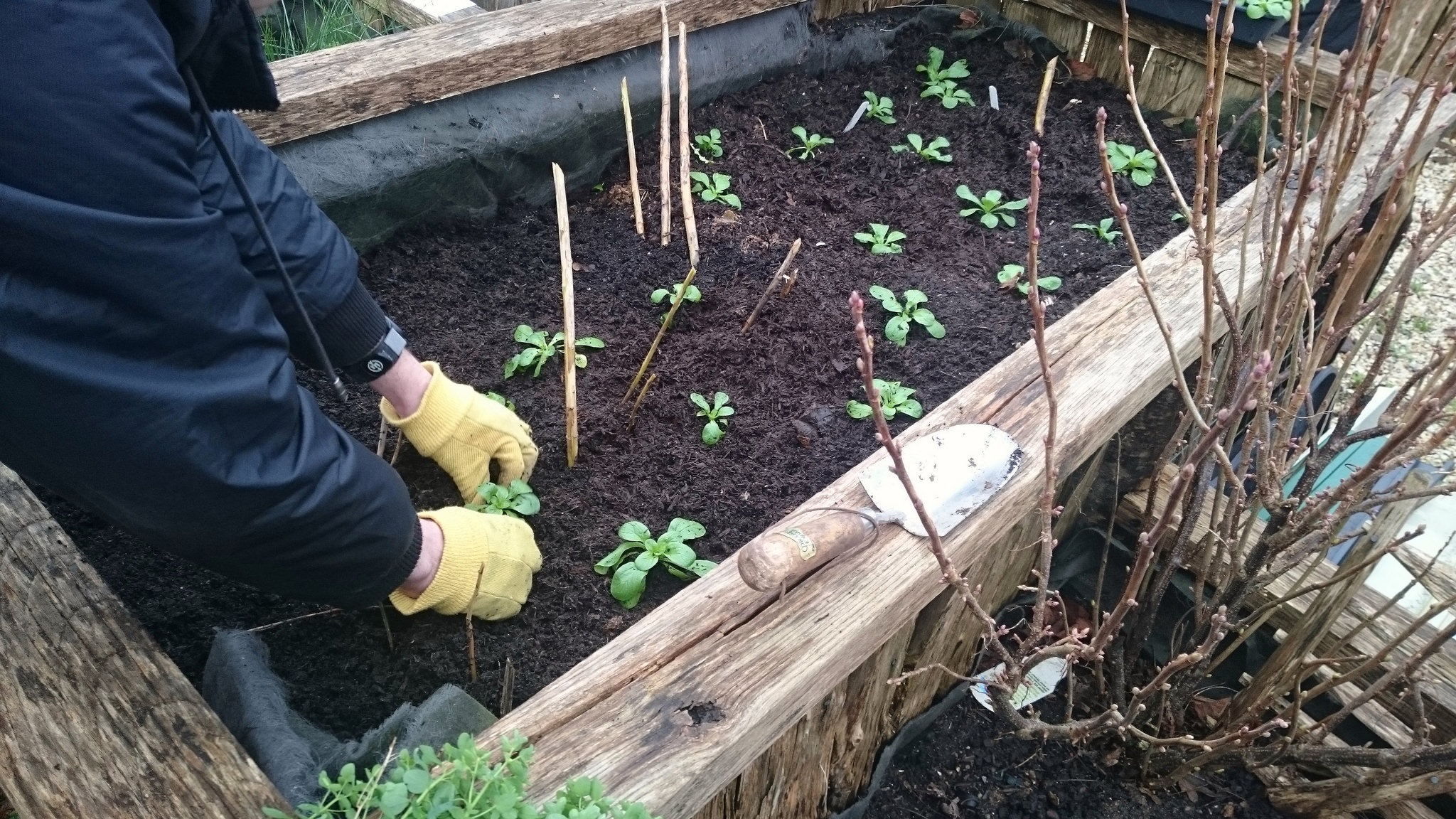
It was a blustery day. Various tasks were done, such as planting corn salad (above), and weeding.
Then we stopped for a fire and a Christmas feast. The weather felt a bit mild for just before Christmas, but that didn't stop us having a wonderful time and enjoying the cracking fire. People had come along with food to share. There were delicious sausage rolls, a beautiful pumpkin from the allotment, some wonderful pumpkin scones, vibrant red cabbage slaw and mince pies galore! Bisi had made some blinis with rosemary from the allotment and smeared them with cream cheese.
Sarah, sporting an excellent penguin hat, toasted pumpkin seeds over the fire and added tamari, which is a kind of soy sauce. They were very tasty. We also had marshmallows that we toasted on hazel twigs.
We finished the morning and the feast by singing We Wish You a Merry Christmas and we do indeed wish EVERYONE a merry and peaceful Christmas and a very Happy New Year from Flourish.
Sarah's regular Wednesday morning LOAP allotment drop-in will be back in January 2016.
EC
Hibernation with Michael Blencowe
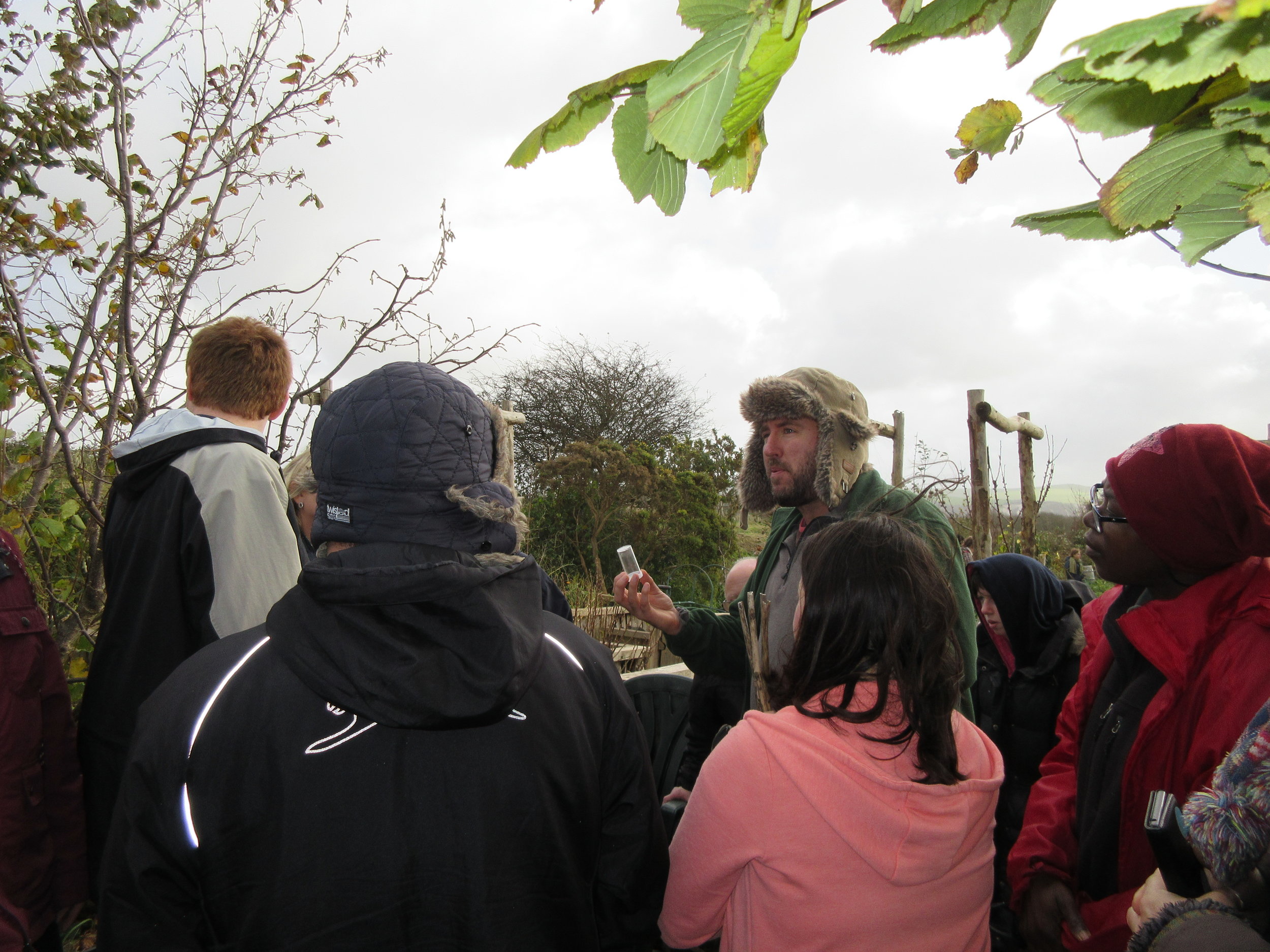 It's always a pleasure to welcome Michael Blencowe from the Sussex Wildlife Trust. Recently, he visited our Wednesday morning group at LOAP, the allotment, to talk about what creatures do in winter - such as hibernate. He showed us how to create tightly-packed tubes that insects can use in the winter. We also moved our lovely new hedgehog house to a quieter spot in the allotment.
It's always a pleasure to welcome Michael Blencowe from the Sussex Wildlife Trust. Recently, he visited our Wednesday morning group at LOAP, the allotment, to talk about what creatures do in winter - such as hibernate. He showed us how to create tightly-packed tubes that insects can use in the winter. We also moved our lovely new hedgehog house to a quieter spot in the allotment.
